Posts Tagged ‘Blue Mountains City Council’
Wednesday, January 18th, 2012
On Sunday 13th November 2006 two separate bushfire ignitions were believed to have been started by lightning just west of the Grose Valley of the Greater Blue Mountains World Heritage Area, according to the Rural Fire Service (RFS). One ignition was located outside the small rural village of Hartley Vale in a valley referred to as Lawsons Long Alley, while the other was in rugged bushland at Burra Korain Head about 4 km east of the village of Mount Victoria. Ten days later catastrophe…
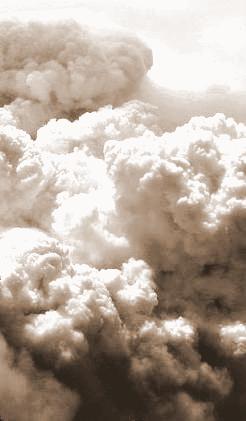 Pyrocumulus cloud as the Grose Valley goes up in smoke on 23rd November 2006 Pyrocumulus cloud as the Grose Valley goes up in smoke on 23rd November 2006
.
‘Two bushfires that were believed to have been started by lightning strikes on Monday are burning in the Blue Mountains National Park. A fire burning 2 km north of Mount Victoria has burnt out about 1100 hectares of private property and parkland and is burning on both sides of the Darling Causeway. The Darling Causeway remains closed to traffic and motorists are advised to use the Great Western Highway and Bells Line of Road as alternate routes.
A second fire burning about 5 km north of Blackheath in the Grose Valley has burnt out about 500 hectares of parkland. Waterbombing aircraft are slowing the progress of the fire as it is burning in difficult and inaccessible terrain.’
[Source: New South Wales Rural Fire Service Blue Mountains website, Fire Name: Lawsons Long Alley, Time Message Issued: 1700, Date Message Issued: 16/11/06, ^http://lists.rfs.org.au/mailman/listinfo/bluemountains-info]
.
At the time the RFS reported that the ‘fire is not threatening any properties or homes at this stage‘, but it was this reassurance that lulled the fire fighting effort into a false sense of security. Over the coming days the fires were not earnestly suppressed but instead allowed to burn out of control as neither were ‘threatening any properties or homes at this stage‘. Famous last words. Worse was that a series of broadscale backburns were started by the RFS at Hartley Vale, Blackheath and along Bells Line of Road – each of which at times got out of control.
.
Comparison with 2003 Canberra Firestorm
.
Three years prior, four ignitions that had been purportedly been sparked by lighting on 8th January 2003 were allowed to burn out of control in remote bushland outside Canberra, Australian Capital Territory (ACT), and starting outside the ACT in NSW. At the time, those fires were deemed not to be threatening any properties or homes at that stage too. Ten days later, the four fires – McIntyre’s Hut Fire, the Bendora Fire, the Stockyard Spur Fire and the Mount Gingera Fire all coalesced into what became known as the 2003 Canberra Firestorm in which four people perished.
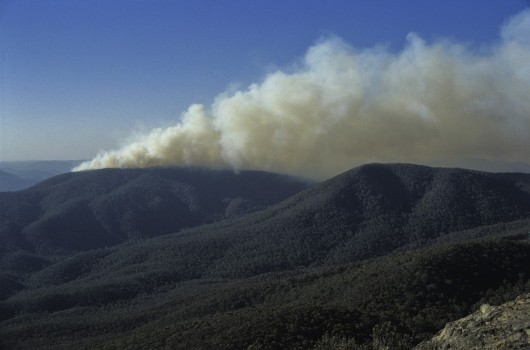 McIntyre’s Hut Fire 20030108 – distant, isolated and remote at this stage.
Ten days later it became the 2003 Canberra Firestorm McIntyre’s Hut Fire 20030108 – distant, isolated and remote at this stage.
Ten days later it became the 2003 Canberra Firestorm
.
Three years hence, the two bushfires west of the Grose Valley after seven days had coalesced into what has become known as the 2006 Grose Valley Fires that ended up incinerating 14,070 hectares of wild bush habitat, including the iconic Blue Gum Forest down in the Grose Valley inside the Greater Blue Mountains World heritage Area .
Both catastrophic bushfires were ultimately the responsibility of the RFS in New South Wales to suppress in order to prevent them becoming uncontrollable firestorms. The RFS failed catastrophically on both occasions with RFS Commissioner Phil Koperberg at the helm. The lessons from the 2003 Canberra Firestorm had not been heeded.
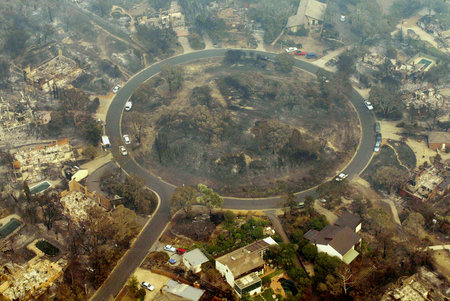 An aerial view of a fire-devastated Chauvel Circle in the suburb of Chapman on 21st January, 2003 in Canberra,
where 15 of 20 homes in the street were destroyed by fire.
Four people were killed and 419 homes destroyed when the fires being fought on five fronts swept through the nation’s capital.
(Photo by Daniel Berehulak, Getty Images) An aerial view of a fire-devastated Chauvel Circle in the suburb of Chapman on 21st January, 2003 in Canberra,
where 15 of 20 homes in the street were destroyed by fire.
Four people were killed and 419 homes destroyed when the fires being fought on five fronts swept through the nation’s capital.
(Photo by Daniel Berehulak, Getty Images)
.
According to the report of the official enquiry into the 2003 Canberra Firestorm by ACT Coroner Maria Doogan, she states:
‘During the inquiry it was submitted that the severity of the firestorm could not have been foreseen. I do not accept this. Australia has a recorded history of extreme fire events dating back to at least 1851. As discussed in Chapter 7 (of the Coroner’s Report), CSIRO fire expert Phil Cheney predicted several years ago a conflagration of the type experienced in January 2003. He made his prediction on the basis of information in the report of one of the seven inquiries that have been held since 1986 to examine various aspects of the ACT’s emergency services.
‘The point to make here is that experiences in life, be they good or bad, serve no useful purpose if we fail to learn from them. It is hoped, therefore, that the many lessons that can be learnt from this catastrophe in the ACT are in fact learnt and result in positive action, not just supportive words and shallow promises.’
[Source: ‘The Canberra Firestorm: Inquest and Inquiry into Four Deaths and Four Fires between 8 and 18 January 2003’, Vol 1, Ch1, pp.2-3., by ACT Coroner]
.
Blue Mountains Council’s response to the 2006 Grose Valley Fires
.
The 2006 Grose Valley Fires coalesced into a conflagration on Thursday 23rd November 2006 down in the World Heritage Grose Valley. Many in the local Blue Mountains community were outraged that this could have been allowed to have occurred. Public demands for answers finally led Blue Mountains Council two months later on Tuesday 30th January 2007 to agree to support the call of ‘concerned residents’ for the New South Wales Government to undertake a thorough, independent review of the Grose Valley Fires.
It is important to note that at the time there was a Labor Government in New South Wales, which was ultimately held responsible for both the 2003 and 2006 bushfire emergency responses.
The following is a copy of the official meeting minutes of Blue Mountains Council’s Ordinary Meeting of 20070130, two months after the 2003 Grose Valley Fires:
.
‘A Motion was moved by Councillors (Terri) Hamilton (Independent) and (Daniel) Myles (Liberal):
.
1. That the Council gratefully acknowledges the efforts of all the volunteers, professionals and agencies that worked together to control the recent Grose Valley Fire.
.
2. That the Council, in order that improvements in fire management can continue for the Blue Mountains and other parts of NSW, as a matter of urgency, writes to the Premier of New South Wales, the Hon Morris Iemma, stating it supports the call of concerned residents on the New South Wales Government, which appeared on page 13 of the Blue Mountains Gazette of 6 December, 2006, as follows:
“1. Undertake a thorough, independent review of the Grose Valley Fire, involving all stakeholders with particular attention to the following questions:
- Were fire detection and initial suppression timely and adequate?
- Were resources adequate, appropriate and supported?
- Were the adopted strategies the best available under the circumstances?
- Could other strategies of closer containment have offered lower risk to the community, better firefighter safety, higher probabilities of success, lower costs and less impact on the environment?
- Was existing knowledge and planning adequately utilised?
- Is fire management funded to the most effective way?
2. Ensure adequate funding is available for post-fire restoration, including the rehabilitation of environmental damage.
3. Fund more research to improve understanding of fire in the Blue Mountains landscape and methods for fire mitigation and suppression.
4. Improve research and training in strategies for controlling fires in large bushland areas.
5. Improve pre-fire planning to support decision-making during incidents.
6. Improve systems to ensure that local fire planning and expertise is fully utilised during incidents, and that the protection of the natural and cultural values of World Heritage areas and other bushland are fully considered.”
.
3. That the independent review includes addressing the questions raised by Blue Mountains Conservation Society:
a. The Blue Mountains City Council therefore supports the following adopted position of the Blue Mountains Conservation Society and would like the review to address the following questions:
i. In what circumstances are back burning from the “Northern Strategic Line” and the Bells Line of Road appropriate?
ii. What can be improved to ensure that lightning strikes or arson fires are contained as quickly as possible?
iii. What can be done to better manage fire risk in the Grose Valley in terms of preparation and suppression to minimise damage to people, property and biodiversity?
iv. What is needed to allow remote area fire teams to be able to work at night when conditions are more benign?
v. How can funding of bushfire management and suppression be changed to reduce overall costs to the community. (Federal funding of suppression under section 44 means funding for trail maintenance and planning is limited.)
.
b. If practicable, would the review also address the following?
i. The World Heritage Area contains a number of threatened species and ecological communities that, in addition to the direct threats associated with climate change, are particularly vulnerable to increased fire frequency and intensity.
ii. The effects on biodiversity of the fire regimes in the Grose Valley over the last 40 years, where there has been a succession of large intense wild fires without sufficient interval between them.
iii. Climate change predictions suggest a probability of more frequent and more intensive fire events, with significant implications for fire management and integrity of ecosystems.
iv. The Blue Mountains City Council also supports and requests involvement in the forum being organised by the Director of the Central Branch of the National Parks and Wildlife Service, Bob Conroy, on the 17 February 2007.
.
4. That the Council emphasises that the requested review should be of a scientific and technical nature.
.
5. That a copy of this letter be forwarded to the Minister for Emergency Services, the Hon Tony Kelly, the Member for the Blue Mountains, the Hon. Bob Debus, and the New South Wales Opposition Leader, Peter Debnam.
.
Upon being PUT to the Meeting, the MOTION was CARRIED, the voting being:
FOR:
- Fiona Creed (Liberal)
- Terri Hamilton (Independent)
- Pippa McInnes (Greens)
- Daniel Myles (Liberal)
- Kerrin O’Grady (Greens)
- Lyn Trindall (Blue Mountains First
.
AGAINST:
- Mayor Jim Angel (Labor)
- Kevin Frappell (Labor)
- Alison McLaren (Labor)
- Adam Searle (Labor)
- Chris Van der Kley (Liberal) and Chair of Blue Mountains Bush Fire Management Committee
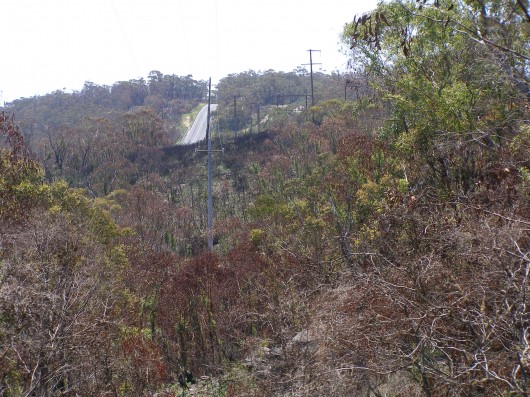 The Hartley Vale backburn 20061115 escaped up Hartley Vale Road and over the Darling Causeway (above) toward the Grose Valley to the right
(Photo by Editor 20070204, free in pubic domain, click to enlarge) The Hartley Vale backburn 20061115 escaped up Hartley Vale Road and over the Darling Causeway (above) toward the Grose Valley to the right
(Photo by Editor 20070204, free in pubic domain, click to enlarge)
..
Editor’s Note:
Ahead of the Blue Mountains Council voting for the above motion, two Labor Councillors, Clr Chris Van der Kley (also Chair of the Blue Mountains Bush Fire Management Committee) and Clr Kevin Frappell (Labor) moved an alternative motion, however it was lost upon voting. This proposed alternative motion was labelled an ‘amendment’ but it was significantly different in detail. The proposed amendment excluded calls for an independent review (per the first item in the original motion).
This proposed amendment also excluded asking the six key questions put by the concerned residents such as ‘Were fire detection and initial suppression timely and adequate?‘, ‘Is fire management funded to the most effective way?‘, etc.
This proposed amendment also excluded that part of Item 1 which recommended strategic improvements to bushfire management such as ‘Ensure adequate funding is available for post-fire restoration, including the rehabilitation of environmental damage‘ and ‘Fund more research to improve understanding of fire in the Blue Mountains landscape and methods for fire mitigation and suppression‘, etc.
This proposed amendment instead drew upon the view of the leadership of the Blue Mountains Conservation Society at the time that considered an independent enquiry would equate to criticism and assigning blame and so be politicised. This did however include advocating “an interagency and technical review process, to tease out the lessons learned.”
.
The Amendment (although lost in the Council voting) is important for the record and read as follows:
1. That the Blue Mountains City Council gratefully acknowledges the efforts of all the volunteers, professionals and agencies that worked together to control the recent Grose
Valley fire.
.
2. That the Blue Mountains City Council supports the recent position adopted by the Blue Mountains Conservation Society in relation to the Grose Valley fire in November
2006. We note and support the position of the Society when it says,
“The circumstances of the bushfire are complex and it is not in anyone’s interest for criticism or blame to be apportioned. However, there is much to be gained by looking at what was done and how it can be improved. The Society does not therefore support a large public inquiry and its attendant politicisation. Instead, the Society advocates an interagency and technical review process, to tease out the lessons learned.”
.
3. That the Blue Mountains City Council therefore supports the following adopted position of the Blue Mountains Conservation Society and would like the review to
address the following questions:
- In what circumstances are back burning from the “Northern Strategic Line” and the Bells Line of Road appropriate?
- What can be improved to ensure that lightning strikes or arson fires are contained as quickly as possible?
- What can be done to better manage fire risk in the Grose Valley in terms of preparation and suppression to minimise damage to people, property and biodiversity?
- What is needed to allow remote area fire teams to be able to work at night when conditions are more benign?
- How can funding of bushfire management and suppression be changed to reduce overall costs to the community. (Federal funding of suppression under Section 44 means funding for trail maintenance and planning is limited.)
.
If practicable, would the review also address the following?
- The World Heritage Area contains a number of threatened species and ecological communities that, in addition to the direct threats associated with climate change, are particularly vulnerable to increased fire frequency and intensity.
- The effects on biodiversity of the fire regimes in the Grose Valley over the last 40 years, where there has been a succession of large intense wild fires without
sufficient interval between them.
- Climate change predictions suggest a probability of more frequent and more intensive fire events, with significant implications for fire management and
integrity of ecosystems.
- That the Blue Mountains City Council also supports and requests involvement in the forum being organised by the Director of the Central Branch of the National Parks and Wildlife Service, Bob Conroy, on the 17 February 2007.
.
Upon being PUT to the Meeting, the AMENDMENT was LOST, the voting being:
FOR:
- Mayor Jim Angel (Labor)
- Kevin Frappell (Labor)
- Alison McLaren (Labor)
- Adam Searle (Labor)
- Chris Van der Kley (Liberal, and Chair of Blue Mountains Bush Fire Management Committee)
.
AGAINST:
- Creed (Liberal)
- Hamilton (Independent)
- McInnes (Greens)
- Myles (Liberal)
- O’Grady (Greens)
- Trindall (Blue Mountains First)
.
[Source: Blue Mountains Council’s Ordinary Meeting, 20070130, Minute No. 7, File Ref. C01095. Subject: ‘Grose Valley Fire’, pp.15-16]
.
Editor’s Analysis:
.
- Similar failure by the RFS and the National Parks and Wildlife Service (NPWS) to muster all available necessary resources to suppress and extinguished both the Lawson’s Long Alley and Burra Korain Head fires, demonstrated that lessons from the 2003 Canberra Firestorm had not been learnt. Critical time was lost in the initial days of the ignitions at both to effectively suppress the fires while they were of a small size and weather conditions relatively favourable to enable suppression.
- The RFS strategy to apply excessive broadscale backburning on multiple fronts at at Hartley Vale, Blackheath and Bells Line of Road exacerbated the complexity and scale of both fires and in the most part contributed to the conflagration of all the fires down in the Grose Valley on 23rd November 2006
- The shortcoming of not mustering all necessary resources to suppress and extinguish bushfires, irrespective of whether a fire is immediately affecting property and homes or not, is flawed, negligent and only heightens the inherent risk of a bushfire escalating out of control. The risk of a bushfire escalation into uncontrollable firestorm is heightened as time allows for the prospect of worsening bushfire weather conditions – increased wind, wind gusts, wind direction, temperatures, and lowering humidity – contributory factors in both the respective Canberra and Grose Valley Fires. There is no indication that this operational culture has changed.
- That a bushfire is situated in inaccessible terrain is not an excuse for bushfire management not to muster all airborne and RAFT resources to suppress and extinguish it as soon as feasibly possible
- After local community realisation that the bushfire had overrun the Grose Valley including burning through the iconic Blue Gum Forest on 23rd November, an informal collection of local ‘concerned residents‘ formed numbering 143 and co-ordinated by Blue Mountains resident Ian Brown. By Wednesday 6th December, within days of the fire finally being suppressed (3rd Dec), this informal group had collectively paid for a full page letter in the Blue Mountains Gazette newspaper costing $2,131.40(page 13). The letter was entitled ‘Burning Issues – fire in the Grose Valley – A statement funded and supported by concerned residents‘. The context was that detailed in Council’s carried motion above.
- Blue Mountains Council’s response was simply a manifestation of the “supportive words and shallow promises” whom ACT Coroner Maria Doogan had cautioned in the Coroner’s Report into the 2003 Canberra Firestorm. No effective Council follow up to its supportive words was undertaken. Sure per Council’s carried motion, Council’s then acting General Manager, Dave Allen, sent off the letter with supportive words to the NSW Premier Morris Iemma, on 20th February 2007, but Council took no other review or enquiry action.
- In the Central Blue Mountains, there are three government agencies responsible for bushfire management – the New South Wales Rural Fires Service, the National Parks and Wildlife Service as part of the NSW Department of Environment (what ever its frequently changing title) and Blue Mountains Council. Collectively these three bodies have co-operated under the Blue Mountains Bush Fire Management Committee, which was/is chaired by Blue Mountains Councillor Chris van der Kley.) and is responsible for planning in relating to bush fire prevention and coordinated bush fire fighting, as well as responsible for advising the Commissioner on bush fire prevention; mitigation and coordinated bush fire suppression. Included on the Committee is also the Commissioner of the RFS, and a nominated representative respectively from the NSW Fire Brigades, Forests NSW, NPWS, the Local Government Association of NSW, the Shires Association of NSW, the NSW Rural Fire Service Association, NSW Police, a nominee of the Minister for the Environment (then Bob Debus), a representative of the Nature Conservation Council of NSW, a person appointed by the Minister on the recommendation of the NSW Farmers Association, a representative of the Department of Community Services and a representative of the Department of Lands. In March 2008, the Blue Mountains Bush Fire Management Committee (BMBFMC) staged a series of community workshops on the Plan’s review process. The Plan was approved on 14th December 2000 with a required review every five years. So by the Grose Valley Fire, the Plan was a year out of date and by March 2008 the Plan was three years out of date.
- It is not surprisingly that the above proposed amendment to the Council letter to the NSW Premier excluded calls for an independent review. Those who proposed the motion and who voted for it were either all Labor Party members or in the case of Liberal Councillor Chris Van Der Kley, Chair of the Blue Mountains Bush Fire Management Committee who was operationally involved. An independent enquiry and the proposed strategic improvements to the bushfire management establishment would have likely revealed operational and government failings and recommended changes to the RFS structure, strategies, and management and importantly to its culture. The amendment was rejected anyway due to Labor having insufficient votes on Council.
- On Sunday 13th November 2006 two separate bushfire ignitions were believed to have been lit by lightning just west of the Grose Valley of the Greater Blue Mountains World Heritage Area by the RFS. Following a back burn/hazard reduction burn that had got out of control up Hartley Vale Road and crossed the Darling Causeway, on Wednesday 15th November the RFS declared a formal escalation to a Section 44 bushfire emergency. This four day delay in detection and suppression is unexplained by the RFS.
- Despite the calls by the concerned residents (with Blue Mountains Council’s supportive words) for the ‘NSW Government to undertake a thorough, independent review of the Grose Valley Fire, involving all stakeholders, so such independent review was done.
- The local Labor member for the NSW Seat of Blue Mountains at the time and NSW Minister for the Environment was Bob Debus MP, who categorically refused requests for either an independent review or a public review into the management of the Grose Valley Fires.
- The Blue Mountains Conservation Society (BMCS) similarly rejected calls for a public enquiry, stating “the circumstances of the bushfire are complex and it is not in anyone’s interest for criticism or blame to be apportioned. However, there is much to be gained by looking at what was done and how it can be improved. The Society does not therefore support a large public inquiry and its attendant politicisation. Instead, the Society advocates an inter-agency and technical review process, to tease out the lessons learned.” It needs to be pointed out that key committee members of the BMCS were/are also active members of the RFS, which raises the issue of and actual or perceived conflict of interest.
- There were two reviews of sorts, none independent and none public.
- On Tuesday 19th December 2006 there was apparently an ‘Inter-Agency Review‘ which took place at Katoomba behind closed doors by members of bushfire management and operating personnel involved in the fire fighting. Despite requests by this Editor, no minutes or reports of that meeting were ever forthcoming. The meeting was internal and secret.
- On Saturday 17th February 2007, there was a ‘Grose Valley Fire Forum‘ held at Mount Tomah organised by Director of the Central Branch of the National Parks and Wildlife Service, Bob Conroy, and the Blue Mountains World Heritage Institute. Only selected participants were permitted to attend – mainly from the bushfire management, fire experts and selected members of the Blue Mountains Conservation Society. A copy of the report of that forum will be publicised on this website shortly.
- Following ongoing community concerns about the lack of transparency, no evidence of any lessons being learned from the Grose Valley Fires and even of a cover up into some of the operational decisions, in January 2007 Bob Debus MP announced a suggestion of there being an Environmental Summit to be staged in the Blue Mountains to provide the first public forum into important environmental issues affecting the Blue Mountains region, notably to discuss the Grose Valley Fire. Well, by the time the summit eventuated it was over a year later and held on the weekend of 23rd and 24th February 2008. By then Bob Debus had moved to federal politics (though still representing the Blue Mountains via the Seat of Macquarie. The summit was chaired by the RFS Commissioner responsible for the 2006 Grose Valley Fires, Philk Koperberg (now local Labor MP) and even the bushfire Incident Controller of the 2006 Grose Valley Fires, RFS Superintendent Mal Cronstedt, was in attendance. However, the summit was now called a conference and the agenda had expanded to many issues including Energy, Social Systems, Natural Systems and Water. Discussion about bushfire was restricted to a two hour workshop and so available time to the Grose Fire to one or two questions which copped only official spiel. It was a classic Labor tactic or stalling on accountability until the community gives up or forgets.
- Since 2006, the Blue Mountains community still doesn’t know whether in the 2006 Grose Valley Fire or currently:
- Fire detection and initial suppression was/is timely and adequate?
- Whether bushfire management resources were/are adequate, appropriate and supported?
- Whether in the Grose Valley Fire the adopted strategies were the best available under the circumstances?
- Whether other strategies of closer containment could have offered lower risk to the community
- Whether currently it has better firefighter safety, higher probabilities of success, lower costs and will cause less impact on the environment?
- Whether existing knowledge and planning is adequately utilised?
- Whether bushfire management is funded to the most effective way?
- Is adequate funding available for post-fire restoration, including the rehabilitation of environmental damage?
.
Another three years hence, in the Blue Mountains we have witnessed from afar the catastrophic Victorian ‘Black Saturday’ Bushfires of 7th February 2009.
.
Another three years hence in 2012, have we learnt anything?
.
Tags: 2003 Canberra Firestorm, Bliue Mountains Conservation Society, Blue Gum Forest, Blue Mountains Bush Fire Management Committee, Blue Mountains City Council, Blue Mountains National Park, broadscale backburning, Burra Korain Fire, Burra Korain Head, funding of bushfire management, Grose Valley Fire Forum, Grose Valley Fires 2006, Labor Government, Lawsons Long Alley Fire, McIntyre's Hut Fire, Northern Strategic Line, NSW Rural Fire Service, RFS, RFS Commissioner Phil Koperberg, RFS Superintendent Mal Cronstedt
Posted in Blue Mountains (AU), Threats from Bushfire | No Comments »
Add this post to Del.icio.us - Digg
Monday, January 16th, 2012
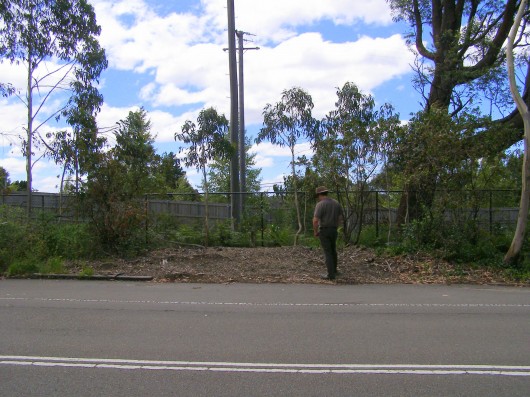 The site of Blue Mountains Significant Tree #5 – it was a massive Eucalyptus oreades
~ Our endemic heritage woodchipped into oblivion
Lest we forget!
(Photo of Editor 20120111, free in public domain, click photo to enlarge) The site of Blue Mountains Significant Tree #5 – it was a massive Eucalyptus oreades
~ Our endemic heritage woodchipped into oblivion
Lest we forget!
(Photo of Editor 20120111, free in public domain, click photo to enlarge)
.
This mature native tree was respected enough to have been listed on Blue Mountain Council’s Significant Tree Register. Indeed it was the 5th such listed tree on Blue Mountains Council’s Register of Significant Trees back in 1988.
So what is the meaning of a ‘Significant Tree‘ on Blue Mountains Council’s register?
Well back on 21st June 1988 the Register of Significant Trees was adopted by Blue Mountains Council as an integral part of its Development Control Plan, which proclaimed significant trees be protected under Clause 6 ‘Protection of Items Listed in the Register of Significant Trees‘ so that:
.
‘No person shall ringbark, cut down, top, lop, injure, wilfully destroy or cause damage to the root system off any tree listed on the Register of Significant trees without consent of Council.’
.
Perhaps the current Blue Mountains Council mayor may care to publicly explain why its Significant Tree Number 5, a locally endemic Eucalyptus oreades (Blue Mountains Ash) of some stature located opposite 252 Old Bathurst Road Katoomba (Lot 2 DP707) has been woodchipped into oblivion?
- Was formal Blue Mountains Council consent given to kill it?
- If so, when was this Blue Mountains Council consent given to kill it?
- What Blue Mountains Council documentation is publicly available to validate such consent?
- What public notice was provided by Blue Mountains Council for community consultation about its killing?
- Does Blue Mountains Council give a bleeding toss?
.
The objectives of Blue Mountains Council’s Significant Tree Register include:
.
(a) identify and protect those trees listed on the Register
(b) promote greater public awareness of the existence of the Register, and the individual items listed
(c) ensure existing and, importantly, prospective land owners, are made aware of the Significant Trees which may be located on their property
(d) ensure correct on-going care and maintenance of those trees listed, through the recommendations included with the significant tree register
.
The following tree is not even on the Blue Mountains Council Significant Tree Register, so has even less chance of protection.
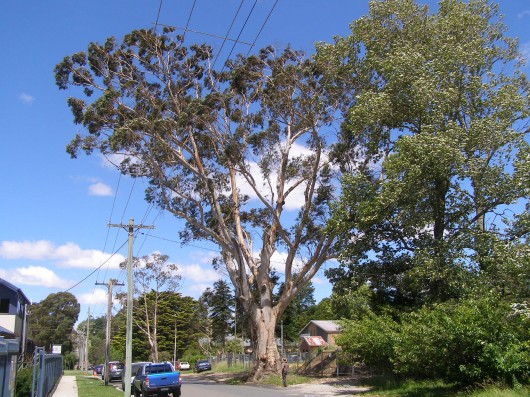 Katoomba’s most significant (grandfather) Eucalyptus oreades, beside Megalong Street
Pitifully it manages to survive as an extremely rare relic of the once magnificent Oreades Forest
This tree is ‘endemic’ to the Central Upper Blue Mountains at Katoomba
(That is, it grows naturally nowhere else on the friggin Planet!)
(Photo of Editor 20120111, free in public domain, click photo to enlarge) Katoomba’s most significant (grandfather) Eucalyptus oreades, beside Megalong Street
Pitifully it manages to survive as an extremely rare relic of the once magnificent Oreades Forest
This tree is ‘endemic’ to the Central Upper Blue Mountains at Katoomba
(That is, it grows naturally nowhere else on the friggin Planet!)
(Photo of Editor 20120111, free in public domain, click photo to enlarge)
.
But this tree is perpetually being subjected by Blue Mountains Council approved industrial development after industrial development – the road widening, the recent expansion of the bus depot across the road and now some ‘mega industrial’ estate behind it. Blue Mountains Council pro-development forces are mounting against it.
.
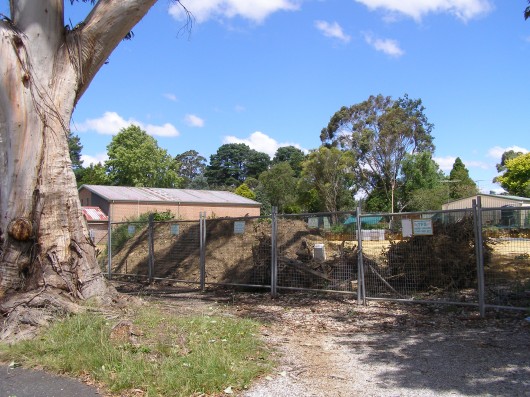 The Mega industrial development immediately behind this magnificent native tree
~ but what would BMCC care?
(Photo by Habitat Investigator 20120111, free in public domain, click photo to enlarge) The Mega industrial development immediately behind this magnificent native tree
~ but what would BMCC care?
(Photo by Habitat Investigator 20120111, free in public domain, click photo to enlarge)
.
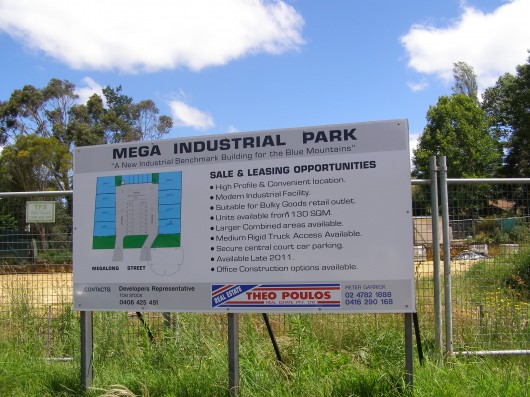 The Theo Poulos promoted ‘Mega Industrial Park’
excavated right behind this rare, significant Eucalyptus oreades,
~ as if the developer or Theo Poulos gives a crap!
(Photo by Habitat Investigator 20120111, free in public domain, click photo to enlarge) The Theo Poulos promoted ‘Mega Industrial Park’
excavated right behind this rare, significant Eucalyptus oreades,
~ as if the developer or Theo Poulos gives a crap!
(Photo by Habitat Investigator 20120111, free in public domain, click photo to enlarge)
.
But then Blue Mountains Council’s so-called Significant Tree Register has always been a crock of deceptive community greenwashing!
As soon as any tree on its register becomes slightly inconvenient, our pro-development Blue Mountains Council, strangled by Liberal-Labor Party vested interests, easily turns a blind eye to significant Blue Mountain heritage and no more significant tree.
Is it any wonder that as the Blue Mountains is allowed to be developed and its natural amenity destroyed that outsiders no longer see the Blue Mountains as a significant attraction, but more as an extension of Sydney sprawl? They just speed past on that forever faster, noisier and more dangerous Trucking Expressway!
.
Tags: Blue Mountains, Blue Mountains City Council, Blue Mountains Council, Blue Mountains Significant Tree Register, Blue Mountains World Heritage Area, endemic, Eucalyptus oreades, industrial development, Lest we forget, Megalong Street, Oreades Forest, significant trees
Posted in Blue Mountains (AU), Threats from Development, Threats from Greenwashing | 1 Comment »
Add this post to Del.icio.us - Digg
Tuesday, January 3rd, 2012
[The following article was initially published as a letter in the local Blue Mountains Gazette (BMG) newspaper on page 4 by this Editor 20081008 under the title ‘RTA Juggernaut‘. It was sparked by reading two separate letters in the paper from Bullaburra residents angry with the RTA and the highway widening process. Copies of those letters are at the end of this article – one by long time Bullaburra resident Viki Wright Rivett; the other by lifetime Bullaburra resident and local historian Una King.]
.
Note: RTA = New South Wales Roads and Traffic Authority; GWH = Great Western Highway
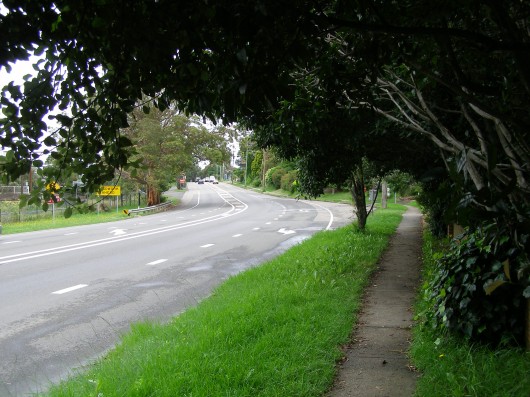 Bullaburra’s rural amenity
Looking east along Great Western Highway towards Railway Station (left)
(Photo by Editor 20110115, free in public domain, click photo to enlarge) Bullaburra’s rural amenity
Looking east along Great Western Highway towards Railway Station (left)
(Photo by Editor 20110115, free in public domain, click photo to enlarge)
.
Decades of complacency and naivety, or do residents of bucolic Bullaburra simply deserve rights to quiet enjoyment and their buena vista? The RTA highway juggernaut is at the door. It won’t just ‘bisect’ the community [‘Anger at RTA‘ BMG 1-10-08]; it will permanently segregate it, raze its rural amenity and degrade it into a noisy truck side stop. Bullaburra is set to receive the same utility vision imposed on Blaxland and so many other Mountains communities.
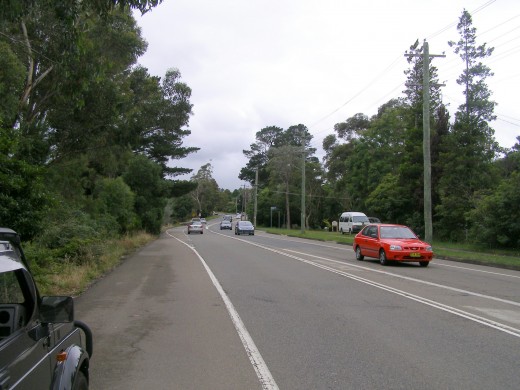 Bullaburra looking east along Great Western Highway towards Noble Street (far centre)
(Photo by Editor 20110115, free in public domain, click photo to enlarge) Bullaburra looking east along Great Western Highway towards Noble Street (far centre)
(Photo by Editor 20110115, free in public domain, click photo to enlarge)
.
I too attended the August township meeting at Bullaburra’s Progress Association hall, not as a Bullaburra resident, nonetheless as a Mountains resident. At the packed meeting, Bullaburrans unanimously endorsed an alternative plan asking the RTA to accommodate local linkages across what will become another four-lane barrier dividing a local community. Personal experience in dealing with the RTA at Leura, Medlow Bath and Katoomba affirms it doesn’t listen or care. It has just plundered the rare 1820s convict road at Leura, hardly pausing its schedule.
 Bullaburra: “Blue Skies” Village – reads the sign (Aboriginal translation)
Western approach to Bullaburra along the Great Western Highway
(Photo by Editor 20110115, free in public domain, click photo to enlarge)
Bullaburra: “Blue Skies” Village – reads the sign (Aboriginal translation)
Western approach to Bullaburra along the Great Western Highway
(Photo by Editor 20110115, free in public domain, click photo to enlarge)
.
The RTA’s massive budget is only limited by political will. It stands to be key recipient of the new Building Australia Fund of $22,000,000,000 then claims it can’t afford community bridges. Be clear, the RTA’s mandate for ‘progress’ is to build more expressways. Driven by road lobbyists, the RTA is extending greater Sydney’s swelling suburbia like Roman legions extended empire.
‘Few understand how much transport influences land use patterns. Transport leads land use. Once an expressway or railway is built, it is easy to change the zoning and development laws to increase the population along the corridor.’ [Then NSW Minister for Planning, Frank Sartor, SMH 29-9-08, p11].
RTA performance is measured by it maximising road ‘ride quality’ and minimising ‘travel times.’ The RTA juggernaut will remain unstoppable so long as local townships rely upon single-handed last ditch battles. Our freshly elected Mountains councillors should stand up for the people of Bullaburra.
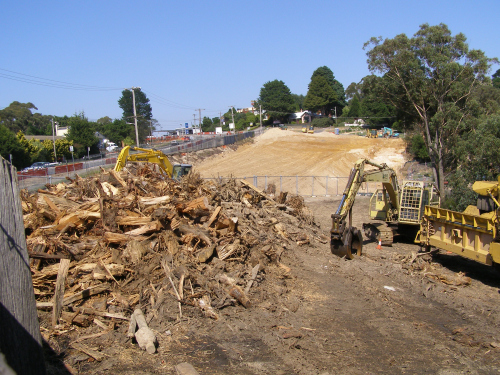 This is what awaits Bullaburra – destruction of rural amenity This is what awaits Bullaburra – destruction of rural amenity
Clearfelled mature native trees at Katoomba to make way for a wider faster trucking expressway
Same project, different section.
(Photo by Editor 20090501, free in public domain)
.
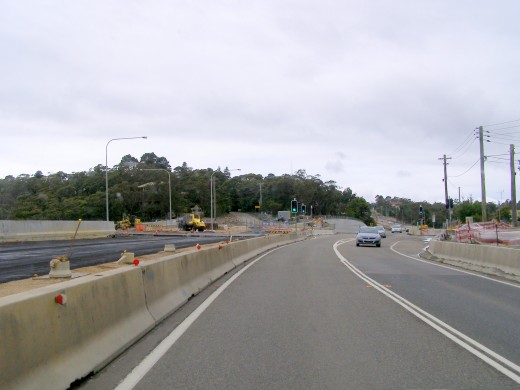 More of what awaits Bullaburra – a trucking expressway amenity! More of what awaits Bullaburra – a trucking expressway amenity!
Eastern approach to Wentworth Falls near Rest Easy Motel (off photo to right).
(Photo by Editor 20110115, free in public domain, click photo to enlarge).
.
.
Following this letter in the weekly local paper, the next week (20081015) the Chairman of the Bullaburra Township Committee, Mr Will Silk, responded as follows:
.
‘Missed Target’
letter by Will Silk in BMG 20081015
.
‘I really don’t know where the author (BMG 08.Oct.2008) is coming from, but he seems to have parachuted into a campaign in the dark and has missed the landing zone.
Steven, a word, to you and other latecomers who are just now arriving from above to hitch themselves to the Bullaburra bandwagon – take the time to find out more about us partisans and the grounds on which we have to work.
At the recent Bullaburra Town Meeting, if you weren’t so blinkered by your condescending stereotyping of a “bucolic Bullaburra”, with its residents slumbering in selfish “complacency and naivety”, you might have seen, heard and, possibly, learned some things of interest to residents’ right activists, environmentalists and radical democrats.
You correctly observed a packed meeting of Bullaburra residents as they unanimously (re-)endorsed the Bullaburra Township Committee’s (BTC) plan to manage the way in which the GWH goes through Bullaburra, and condemned the RTA’s plan.
But, hey, Steven! Where did the BTC Plan come from? It came from 18 years’ proactive work by Bullaburra residents and their organisations. We saw the RTA “juggernaut” coming a long time ago, and instead of just whingeing, we developed our own plan before the RTA did, and we united behind it!
You failed to see that at the meeting, the BTC Plan (with its three integral foundations of pedestrian trian bridge), service road and North-South Bullaburra road-rail bridge) has the unanimous support of all the community organisations in Bullaburra. You also failed to hear all of the now elected ward councillors give our plan their support. And moreover, you didn’t see the now mayor, Adam Searle, and from the Liberal side, Chris van der Kley both, literally “stand up”, together and not for the first time, to show their support.
Far from being naive and complacent, Bullaburra, and the BTC have already put in the hard yards of “politically correct” struggle; delegations, submissions, lobbying. What you failed to see at the meeting was a community gearing up, giving its representatives a very clear mandate, for the next stage in its struggle for a renewed, people and environmentally-friendly village.
We are not “at a last ditch”. But we are about to go to the barricades. We encourage you and all Blue Mountaineers who care about creating such townships to join us if you wish. But leave the mocking paternalism behind. Seeing the RTA as an “instoppable Juggernaut” is defeatist. It is a sort of jaded fatalism that is itself an impotent form of complacency.’
~ Will Silk, President of the Bullaburra Township Committee.
.
.
Harsh defensive words from Mr Silk.
I chose not to reply to Will Silk’s above letter in the local paper, because to have done so would have only detracted Bullaburra residents from their united focus behind Will Silk to deal with the RTA. The aim of my letter had merely been to awaken fence sitting residents to the realisation of the force and power they were dealing with at the RTA. I had witnessed similar David v Goliath community campaigns along the highway, most notably at adjacent Lawson, each village/town community singularly convinced that their case was special and naively campaigning in isolation against the legal might and finances of the RTA.
So I was happy to withdraw my involvement at the time to avoid potential conflict, yet my protest campaign in the local paper broadly against the Trucking Expressway continued through into 2010.
What Mr Silk didn’t realise was that I had been actively involved in previous community campaigns concerning the RTA highway widening stretching back to 2001 when I first arrived in the Blue Mountains. Previous highway campaigns have included Shell Corner (2001-02), Soldiers Pinch (2001-02), Lawson (2003-09), Leura section 1 (2004-05), Medlow Bath (2005 ), Leura section 2 (2006-08), Katoomba (2006-09), Mount Victoria bypass (2006-08) and Bells Line of Road (2005-07).
What Mr Silk also didn’t realise was that at the time I was contracting as a management accountant with the RTA, with some insight into the mechanisations, agendas and management culture of this very much political organisation. What Mr Silk also didn’t realise was that I had researched the history of Bullburra and learnt about the RTA plans for the highway widening through the town.
The RTA plans are set to divide Bullaburra by a faster four-laned expressway, greatly restricting local access and offering very few design concessions to local residents.
.
.
I didn’t have to wait long for the optimistic Bullaburra community sentiments to sour about the likely success of the BTC’s alternative highway design.
The above letter in the local paper by Mr Silk a Chairman of the Bullaburra Township Committee, saw the following week a media release by the Bullaburra Township Committee, headed up with a photo including Will Silk.
.
‘Bullaburra joins highway battle‘
by Michael Cleggett (journalist), BMG 20081022, p3.
.

‘The RTA’s highway-widening roadshow continues to attract jeers wherever it arrives, and this time it’s Bullaburra residents voicing anger at plans for their stretch of tarmac.
Members of the Bullaburra Township Committee (BTC) are furious their own designs for the upgrade have seemingly been ignored.
BTC president Will Silk is concerned the RTA has not fully accounted for the effect of any works on the village and its people.
After years of campaigning to different levels of government and departments, residents were dismayed by the RTA proposal when it was made public earlier this year.
“We went in to see them in the first week of June this year and not to our surprise, but to our disgust, we found that they didn’t even know about our plan, they hadn’t taken it into consideration,” Mr Silk said.
In anticipation of the highway upgrade the community has been looking into the issue for more than 20 years. The three pillars of the BTC designs are a road bridge connecting north and south Bullaburra, a comprehensive service road on the southern side running parallel to the highway and a pedestrian bridge. None of these form part of the RTA’s proposal.
Mr Silk said the BTC’s vision presents a much better opportunity to create “a modern 21st century village with the unavoidable highway through the middle of it”.
The service road is intended to allow residents to traverse the town without having to make a difficult turn onto the highway while the bridges would avoid permanently dividing the town as well as providing easier emergency vehicle access. This stage of work will expand the highway to two lanes in each direction from Noble Street to 600 metres west of Genevieve Road.
Outside of the widening, the main features of the RTA plans involve relocating the commuter car park to the southern side of the highway, moving the pedestrian crossing lights, an access road for some properties between Genevieve Road and Noble Street and a number of other changes to street access and bus stops.
Member for Blue Mountains Phil Koperberg has expressed a willingness to further examine the issue.
“(The BTC) proposal for a link bridge between north and south of the Great Western Highway obviously has merit,” he said. “However, whether or not it is practical, feasible or constructable I’ll take advice from the RTA.”
An RTA pamphlet delivered to residents suggests that advice will be bad news. It describes a comprehensive access road and a pedestrian overbridge as unfeasible.
A spokesperson for the RTA said an information session earlier this month was well attended with “some worthwhile suggestions . . . put forward, which will be investigated”.
A second information session will be held by the RTA from 10am-1pm at Lawson Bowling Club this Saturday, October 25.’
.
.
This article by the Bullaburra Township Committee was then followed up by Bullaburra resident Patrick Tatam, who clearly had a stronger interpretation of how discussions between locals and the Roads and Traffic Association were proceeding.
.
‘RTA Bullaburra fiasco’
by Patrick Tatam, Bullaburra (letter in BMG 20081029, p4)
.
‘Regarding the obstructionist, bullying attitude of the RTA towards the Bullaburra Township Committee (BTC), attacking the BTC’s proposed alternativeplan for the GWH rod widening through Bullaburra, here’s my take on what locals are saying:
- The major political parties are basically inept, unable to listen to constituents and consumed with retaining/grasping power
- Phil Koperberg (then local Labor MP) has no effectively influential power, says anything to avoid an issue, is “a bit of a show pony”, and has furthered his career utilising the ‘who you know, not what you know’ approach
- The RTA is seen as a mob of bureaucratic bullies, are even more incompetent than their political masters (the Hazelbrook railway bridge fiasco is common knowledge), and are responsible/answerable solely to the faceless bosses located deeply within the termite mound of RTA headquarters.
- RTA representatives at community meetings are aggressive, non-consultative, driven only by their own preferred agendas, ill-prepared, and are the antithesis of ‘public servants’
- Exiting either Boronia or Genevieve Road is currently dangerous, and will become definitely more so with the planned RTA ‘seagull’ intersection, increased speed restrictions (from 70kph to 80kph) and higher traffic volumes (particularly those larger faster trucks).
- The BTC’s plan is a far better solution for the Bullaburra area than the ‘crash through or crash anyway’ RTA proposal; it’s a plan that addresses the needs of the people who live here, not the needs of a termite from a city office, and incorporates beneficial infrastructurec, not just ‘bloody minded’ bitumen.
.
Elected government members, and RTA personnel, should realise that they are our representatives, and that locals are becoming more politically astute, voting more for independents, if only to make our representatives more representative. Those bullies that remain, hiding behind the skirts of party machinery, should recall the destiny of the dinosaur. Or just move to the last bastions of ‘Bullyville’: Zimbabwe, Myanmar, etc.
~Patrick Tatam, Bullaburra.
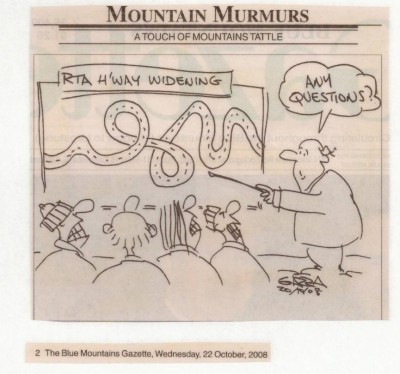
.
.
Editor’s Campaign to Save Bullaburra’s 300+ year old Angophora tree from the RTA
.
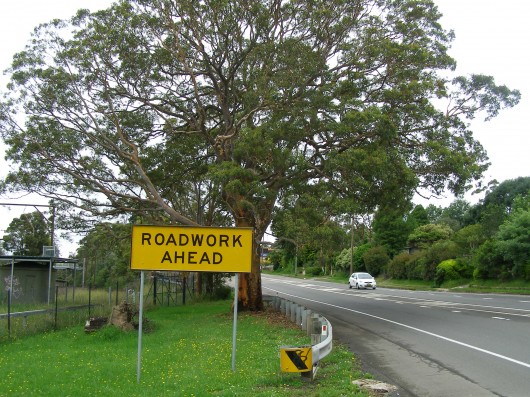 Bullaburra’s Angophora – on RTA’s death row Bullaburra’s Angophora – on RTA’s death row
.
Listed on Blue Mountains Council’s Significant Tree Register
Registered Significant Tree #: 29
Botanical Name: Angophora costata
Common Name: Smooth Barked Apple, Red Gum
Date Registered: 17th July 1985, adopted 21st June 1988
Location: Great Western Highway, Bullaburra, Opp. Lot 173, DP13407.
[Read Significant Tree Register]
.
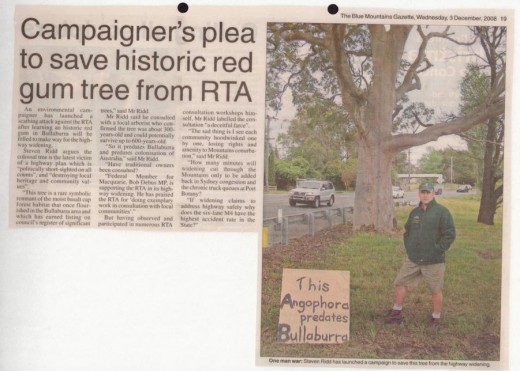 Campaign article in Blue Mountains Gazette 20081203, p19.
.
This followed a quarter page campaign article published in this newpaper on 20081105 costing this Editor $460.
(Click image to enlarge) Campaign article in Blue Mountains Gazette 20081203, p19.
.
This followed a quarter page campaign article published in this newpaper on 20081105 costing this Editor $460.
(Click image to enlarge)
.
.
Letters by Bullaburra residents 20081001
.
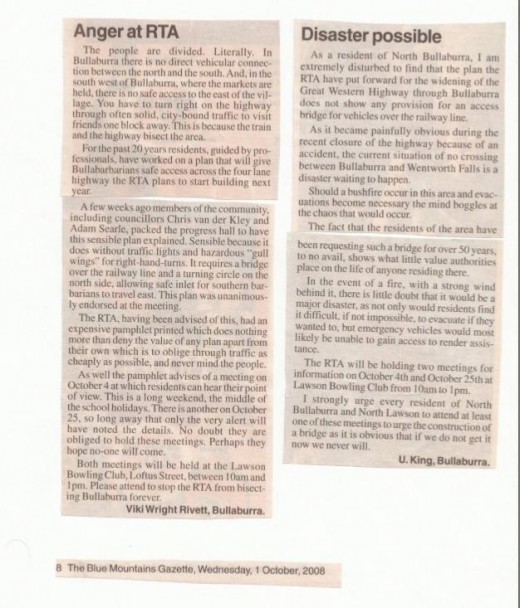 (Click image to enlarge) (Click image to enlarge)
.
Monday, December 12th, 2011
“I wish to explore what remains for most – and has been for me – a terra incognita, a forbidden place, a heart of darkness that civilised people have long attempted to repress – that is, the wilderness within the human soul and without, in that living profusion that envelops all creation.”
.
~ Max Oelschlaeger, The Idea of Wilderness: From Prehistory to the Age of Ecology (1993)
.
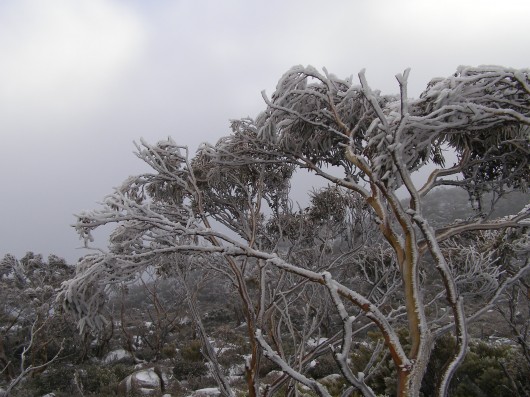 Pinnacle of Mount Wellington, Tasmania
(Photo by Editor 20111001, free in public domain, click photo to enlarge) Pinnacle of Mount Wellington, Tasmania
(Photo by Editor 20111001, free in public domain, click photo to enlarge)
.
In 2007, former United States Vice President Al Gore‘s campaign to educate citizens about global warming was portrayed in an award winning documentary film ‘An Inconvenient Truth‘.
The subject matter, global warming, has indeed become an inconvenient truth because the global scale of the problem is such that the powers that be have so far been finding it difficult to comprehend. They have been told that it demands a response so systemic as to be transformational, which is highly inconvenient for them to say the least. The transformational response is mostly inconvenient to the powerful vested interests in polluting industries that are key contributors to global warming – particularly oil, gas, coal, heavy manufacturing, transport and weapons industries.
.
‘Deluded Convenience’
.
On the flip side of this inconvenience of the truth, powerful vested interests understandably, are hell bent on maintaining their convenient business as usual practices, choosing to ignore, reject and deny the truth. It is their short term interests to do so, because change is expensive and threatens to diminish their power, influence and wealth. But in the long term, by perpetuating practices that are shown to be damaging to the Earth’s climate, the imperative of maintaining a convenient business as usual approach is a deluded one, as everyone will be adversely affected by global warming. They are only deluding themselves. Such harmful business-as-usual practice is a ‘deluded convenience‘.
Harmful business-as-usual practices that are contributing to global warming were once branded aspiringly in the 18th, 19th and 20th Centuries as ‘industrial progress‘. The widespread Western culture from Western Europe and the United States has for over three hundred years idolised the ‘civilised’ advances of the Industrial Revolution, capitalism and economics. Western economies now have many conveniences of lifestyle, but attaining them has caused considerable cost to societies and ecology. Globalisation has destroyed family-based enterprises, local markets and village communities and caused wars and immense suffering. Industrialisation has destroyed many forests, rivers, valleys, coastlines and species. These have been the cost of convenience, the cost of civilisation; and we are now paying the price.
.
“It is fairly widely accepted today that environmental destruction ultimately becomes self-destructive as a sick and impoverished global environment in turn sickens and impoverishes the human members of that ecosystem.
..Why, despite warning signs from a stressed global ecosystem, mounting scientific evidence, and public education campaigns, does degradation of the environment continue to persist and mount?”
.
~ Catherine M. Roach, 2003, ‘Mother Nature: Popular Culture and Environmental Ethics.
.
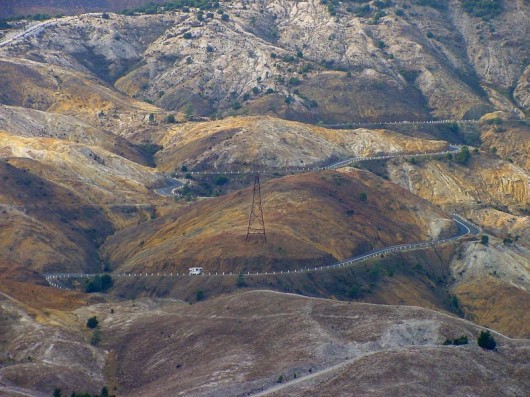 Absolute environmental destruction above Queenstown, Tasmania Absolute environmental destruction above Queenstown, Tasmania
.
Bushphobia – a form of deluded convenience
.
Bushphobia is a composite term emanating from Australia, which combines two words ‘bush’ meaning the native forest and scrub environment of Australia’s unique animals and plants, with the non-clinical use of the term ‘phobia’. Phobia (from Greek φόβος, phóbos: fear, phobia) is an anxiety association, a negative attitudes towards, a dislike, disapproval, prejudice, discrimination, or hostility of, aversion to, or discrimination against something. Bushphobia is borne out of learnt acculturation adopting two distinct attitudes:
- A deep fear of the bush due to its propensity to burn and cause horrific wildfires
- A dislike of Australian native vegetation due to its wild untamed appearance which is so different to exotic trees and landscapes that have a more symmetrical and accessible character
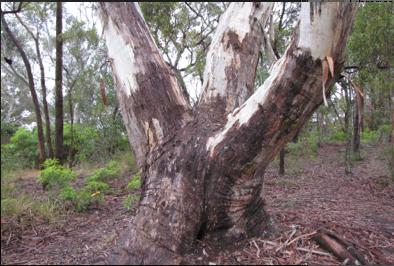 An Australian native tree discriminated against by a pro-development Court ruling…because it may be dangerous
^http://www.savethetree.org/
An Australian native tree discriminated against by a pro-development Court ruling…because it may be dangerous
^http://www.savethetree.org/
In this case a discrimination against the bush, where the word ‘bush’ is an Australian term for native forest and scrubland. Bushphobia was first used with its modern meaning in 2008 in the Blue Mountains in eastern Australia which represents an intolerance and prejudice against the natural Australian bush vegetation mainly because of its susceptibility to burning in the case of bushfires and the consequential fire threat to life and private property.
The combined meaning is to have a persistent irrational fear specific fear or loathing of the natural (bush) environment. There are three classes of phobias: agoraphobia, social phobia, and specific phobia (Wood 521). Bushphobia is a specific phobia associated with a fear of natural environment.
Bushphobia is a socially learnt fear and loathing toward the bush common amongst rural volunteer bushfire fighting organisations which is instilled in new recruits as part of the training tans assimilation process. Bushphobia has thus become a form of learned cultural prejudice amongst the rural fire fighting fraternity throughout Australia. This attitude becomes deep seated and a motive to regard native forests, not as valued natural assets and habitat for native flora and fauna, but only as a combustible fuel that is prone to burn and thus a menace and ‘hazard’. The standard myth conveyed about the bush that inculcates bushphobia is that if the bush is not destroyed and allowed to grow naturally then the bush will develop into an uncontrollable fuel that in the event of a bushfire will cause an horrific fire storm and Armageddon. The issue of inadequate bushfire fighting capabilities is conveniently ignored.
Those who only see the bush through a bushphobic mindset desire to burn it, bulldoze it and destroy it at any opportunity when weather permits such action to be done safely. Deliberate burning of the bush has become a ‘prescribed burning’ policy of Australian governments at both state and federal level attracting massive resources. In New South Wales prescribed burning is labelled ‘hazard reduction’. History however has shown repeatedly that many prescribed burning activities frequently escape control lines an end up destroying vast areas of bush.
.
.
NIMBYism – a celebration of ‘think globally, act locally’
.
The maxim ‘Think globally, act locally‘ has long passed into the vernacular, urging grassroots activism where thinking about the health of the entire planet is translated into taking action at a local level in one’s own community. The phrase has been originally attributed to Scottish town planner and social activist Sir Patrick Geddes FRSE [1854-1932].
 Sir Patrick Geddes (c.1886) Sir Patrick Geddes (c.1886)
.
At a time in the early 20th Century when industrialisation was dramatically altering the conditions of social life, Geddes recognised the role of architectural amenity on urban life, particularly promoting the happiness, health and comfort of all residents, rather than focusing on roads and parks available only to the rich. He applied this in his design of Edinburgh, Tel Aviv and Bombay. Geddes was an advocate of nature conservation and strongly opposed to industrial pollution. Some historians have claimed he was a forerunner of modern Green politics. At a time of rapid urban growth, Geddes coined the term ‘conurbation’ observing how population growth was pushing large towns to merge into one continuous urban and industrially developed area. In Geddes’ 1915 book “Cities in Evolution” his advocacy of maintaining local character in urban planning is clearly evident:
‘Local character’ is thus no mere accidental old-world quaintness, as its mimics think and say. It is attained only in course of adequate grasp and treatment of the whole environment, and in active sympathy with the essential and characteristic life of the place concerned.’
.
Prominent American environmentalist and mountaineer David Brower [1912 – 2000] and founder of Friends of the Earth (FOE) in 1969 is believed to have been the first to applied the phrase ‘think globally, act locally‘ in an environmental context as the slogan for FOE. Application of ‘think globally, act locally‘ maxim in this environmental context has manifest itself most prevalently when grassroots activism erupts as a result of inappropriate land use development threats. Local residents opposing inappropriate development are following the thinking of Geddes by recognising the important value of local amenity to the health and happiness of local residents. Developers are quick to deride the rights of local residents to defend their neighbourhood amenity, labelling them as NIMBY‘s – an acronym for the phrase “Not In My Back Yard“, first coined in 1980 by British writer Emilie Travel Livezey in an article ‘Hazardous Waste‘.
Nimbyism is used typically by proponents of a development to pejoratively describe opposition by neighbouring residents. Nimbyism, however is simply acting locally to protect the values of one’s neighbourhood. Standing by and watching an inappropriate development proceed is an option, but why stand by? Residents who plan to live in a locality for some time and perhaps for the rest of their lives, have a democratic right and a say in what happens to their locality and this includes a say its preserving or changing the locality’s amenity and character. It is about holding strong principles of community governance and valuing the rights of locals to participate in decisions that directly affect them. Local residents are the stakeholders who will have to live permanently with a development and so are most deserving in having a louder voice in development decisions to balance corporate developers and their investors.
Amusing variants of NIMBY are:
- ‘NIMFYE’ = Not In My Front Yard Either
- ‘NIMTOO’ = Not In My Term Of Office [a favourite of politicians]
- ‘NITL’ = Not In This Lifetime
- ‘NOPE’ = Not On Planet Earth
- ‘NOTE’ = Not Over There Either
- ‘GOOMBY’ = Get Out Of My Backyard [Common in new suburbs that encroach on industrial sites or airports]
- ‘NIABY’ = Not in Anyone’s Backyard
- ‘NUMBY’ = Not Under My Backyard (applicable to mining companies)
.
And this Editor’s favourite:
- ‘BANANA’ = Build Absolutely Nothing Anywhere Near Anything
.
.
‘A recent report has found that nearly 80% of U.S. residents oppose any new development in their community. It’s the highest level of opposition recorded in the report’s six-year history, and the first time since 2008 that the amount of opposition has increased.’
.
[Source: ‘As America Ages, NIMBYism Could Increase, by Nate Berg, The Atlantic Cities, 20111017, ^http://www.theatlanticcities.com/politics/2011/10/as-america-ages-nimbyism-could-increase/306/]
Given that Nimyism is a developer term used derogatorily against residents who dare to question and challenge land use development , the counter-language on the side of residents is ‘property rights‘ and ‘planning democracy‘. Many residents out of frustration with the local planning process decide to form an action group. One organisation well experienced in this quest is Sydney-based Save Our Suburbs.
.
Save Our Suburbs
.
‘Save Our Suburbs (NSW) Inc is a non-profit & non-aligned group of residents, originally formed to fight against forced rezoning and over-development of Sydney’s suburbs. It has grown to include communities who are fighting for better planning and regulation on a range of development issues, including major infrastructure projects such as road tunnels. Sydney’s beleaguered residents have been fighting an endless string of localised battles against increased density developments (‘urban consolidation‘) and badly planned developments such as unfiltered tunnel exhaust stacks. We have been fighting local councils about local rezoning and local developments, and state government departments about the lack of regulation and planning. Residents are usually the losers in these local battles. If we want to effectively protect the environment and heritage of our suburbs, we need to take the fight beyond our local areas into the State Government arena. This can only be achieved by organised and united residents. Save Our Suburbs (NSW) Inc has been formed for this very purpose.
.
Fundamental Objectives:
- Return Planning democracy to New South Wales, by allowing true consultation, and giving planning power back to local councils: The people should decide, not a Planning Dictator!
- End big developer donations to political parties: We want planning decisions based on merit, not on money!
- Save our property rights: Provide just compensation for loss of land, income or amenity, and for change of land use.
- End forced urban consolidation- allow sensible land release, with infrastructure funded by the government: Dump the failed planning policies, designed to favour big developers rather than the community.
Read More: ^http://www.sos.org.au/
.
.
Bushphobia – a ‘case’ of deluded convenience
.
‘Our urban footprint is encroaching further and further into bushland. The amount of land used as space for community living is decreasing as urban settlements have sprawled. This is affecting the opportunities we now have to meet and interact as communities. The consequences of urban sprawl include a decline in the supply of affordable housing, increased bushfire risk for individuals and property and increasing impacts on the environment.’
Historically, much of the development in the Blue Mountains has encroached well into bushland with little regard for environmental impact and often without supporting infrastructure, such as sewerage and transport systems. This dispersed, sprawling development pattern along ridgelines has been added to by post war residential development, creating many of the ‘suburbs’, particularly in the lower Blue Mountains. As all available sites for new development dry up it is likely that existing urban areas will come under increasing pressure for redevelopment.’
[Source: Blue Mountains Council, ^http://www.sustainablebluemountains.net.au/imagesDB/resources/Paper14bOurFuture.pdf, p.4]
 An example of current housing encroachment into bushland
Faulconbridge, Blue Mountains, New South Wales, Australia
An example of current housing encroachment into bushland
Faulconbridge, Blue Mountains, New South Wales, Australia
[Source: Century 21 Real Estate, ^http://www.realestateview.com.au/Real-Estate/faulconbridge/Property-Details-buy-residential-2842241.html
.
A case in point involves the current issue about a significant native tree facing death due to the threat of housing development in the Blue Mountains village of Faulconbridge.
About midway along the conurbated highway corridor through the Central Blue Mountains lies the urban village of Faulconbridge. Like all the other villages and towns along this highway, Faulconbridge residential housing ultimately backs on to the Blue Mountains National Park, which forms part of the Greater Blue Mountains World Heritage Area.
 Faulconbridge juxtapositioned to the Blue Mountains World Heritage Area.
[Source: Google Maps]
Faulconbridge juxtapositioned to the Blue Mountains World Heritage Area.
[Source: Google Maps]
.
A local resident action group in St Georges Crescent, Faulconbridge has been recently formed to try to save a significant native tree situated in its natural bush environment from being killed for housing development. The resident group, lead by local Faulconbridge resident Don Cameron, is simply called ‘Save the Tree‘ and a dedicated website has been designed and set up: ^http://savethetree.org
 A mature native tree in a forest but on death row
so that property developers can build a house or two.
(St Georges Terrace, Faulconbridge, Blue Mountains, New South Wales Australia,
Source: ^http://savethetree.org)
.
A mature native tree in a forest but on death row
so that property developers can build a house or two.
(St Georges Terrace, Faulconbridge, Blue Mountains, New South Wales Australia,
Source: ^http://savethetree.org)
.
According the website, the subject tree has been listed on Blue Mountains Council’s Register of Significant Trees since August 1985 – #33. The subject land site where the tree stands comprises remnant bushland including the significant tree as well as three locally rare Faulconbridge Mallee Ash trees (Eucalyptus burgessiana), which is a rare species of flora included on the Australian botanical list of Rare or Threatened Plants (ROTAP).
In early 2010, a development application for two dwellings on the site was submitted to council. The proposal included the removal of a considerable amount of the remaining vegetation including the removal of the significant tree. In that same year, numerous residents submitted objections to the development application. As a result of Council’s notification process, fifteen submissions from local residents were received objecting to the development on the following bases:
- Removal of the significant tree from the site
- Clearing and loss of vegetation, including threatened
- Species of vegetation, and screening of the development
- Impacts on streetscape
- The lot should become public land
- Overdevelopment of the site and the bulk and scale of the development
- The proposed development is out of character with the surrounding development
- Proposed subdivision into 2 lots
- Loss of environmental features of the site
- Increased stormwater impacts and local flooding
- Pedestrian and traffic safety
- Reduced building setbacks
.
[Source: Blue Mountains Council, Ordinary Meeting of 28th June 2011, Section: ‘Using Land for Living’, Item 20, Ordinary Meeting, 28.06.11, p.212, 20. 11/85977. Development Application no. X/443/2010 for a detached dual occupancy consisting of a single storey dwelling and a two storey dwelling…Faulconbridge]
.
Council Planning assessed the Environmental Impacts of the proposed development as follows:
‘There are currently three (3) Faulconbridge Mallee Ash (Eucalyptus burgessiana) located on the subject allotment. This is a rare species of flora which is on the list of Rare or Threatened Plants (ROTAP) published by the CSIRO. While it is acknowledged that Eucalyptus burgessiana are a rare plant, they are not listed as a threatened species under either the Threatened Species Conservation Act or the Environmental Protection and Biodiversity Conservation Act.
‘There are also a number of other indigenous trees on the property including a large Eucalyptus Sclerophylla x Eucalyptus Piperita hybrid which is listed as a significant tree in DCP 9 Significant Trees. The proposed development will result in the removal of much of the vegetation on the site including two (2) of the Eucalyptus Burgessianna and the significant tree. The site also contains a number of significant rock outcrops which are identified by the LEP as a significant natural feature.’
.
The proposed development has been sited to avoid as far as practical impacts on those outcrops. In particular, it is noted that the development has been designed to ensure that both the dwellings and the vehicular driveways are predominantly clear of the two most significant features, being the outcrop adjacent the frontage with St Georges Crescent and the outcrop toward the centre of the lot.
Clause 44(4) provides a hierarchy for considering any adverse environmental impact which may result from any development. This clause requires that any development should be designed and sited so as to have no adverse environmental impact. However the clause goes on to provide that where an adverse environmental impact cannot be avoided and no practicable alternative is available, it is necessary to consider the proposed use of the land with reference to the zone objectives of the land. In this respect, while it would be possible to reduce the impacts if the development was confined to a single dwelling only, it is considered that there are no practicable alternatives that would allow all the rare species and the significant tree to be retained and at the same time, allow the permitted use as a detached dual occupancy.
.
It should also be noted that the significant tree has been assessed as not being viable for retention in any case as the result of extensive decay throughout the trunk. This matter is discussed in more detail in the body of the report.’
.
Biodiversity incremental degradation encouraged by Council Planners
.
The matters for consideration are:
‘ The need to prevent adverse impacts on the near pristine conditions of these subcatchments’
.
Council Planning Response:
‘The proposed development is located on an existing vacant lot within the urban area. There will be a significant amount of vegetation removal but this is unavoidable to provide for development of this site. The site will be revegetated and landscaped.’
(Editor: ‘revegetated’ permits destruction of native bushland in favour of creating an exotic urban garden complete with fertiliser and associated runoff).
Both dwellings will be connected to the sewer.
It is considered that the proposed development will not have any adverse impact on the condition of the Grose River Sub-catchment.
(Editor: What is ignored is the collective impact of multiple development applications on Blue Mountains biodiversity and catchments. The planning guidelines fails to factor the collective death by a thousand cuts).
The proposed development is located clear of the areas of surface rock on the property and has been designed to minimise cut and fill by the use of drop edge beams. While the development will result in the removal of two (2) of the Rare or Threatened Plants listed trees, the site is not part of a contiguous area of bushland and it not considered that their removal will have a significant impact on the species.’
– – –
On 28th June 2011, following Blue Mountains Council’s planning assessment, councillors voted unanimously at a General Meeting to refuse the development application on the basis that it breached Council’s local planning laws. The meeting was addressed by: Don Cameron, Robert Leslie, Rama Decent, Terry Barrett.
A motion was moved by Councillors Searle and McLaren that the Development Application No. X/443/2010 be refused on the following grounds:
- The proposed development is contrary to the objectives for the ‘Living-General’ zone under LEP 2005 in that it does not maintain and improve the character of the area, or respond to the environmental characteristics of the site;
- The proposed development, including the removal of the significant majority of existing trees and other vegetation from the site, will have an unacceptable adverse impact on the established landscape character of the locality;
- The proposed development will have an unacceptable adverse environmental impact and is contrary to the provisions of Clause 44 of LEP 2005 in that it has not been designed and sited to minimise impacts on the rare species of plant Eucalyptus Burgessiana and the destruction of rock outcrops on the property;
- The proposed two storey component of the development will be visually prominent and have an unacceptable impact on the existing streetscape when viewed from St Georges Crescent;
- The proposed development is an over development of the site in terms of the height, bulk and scale of the two storey dwelling fronting St Georges Crescent;
- The proposed development does not comply with Clause 2, Part 1, Schedule 2 – Locality Management within the Living Zones, of LEP 2005 by reason that the rear dwelling encroaches onto the 4 metre secondary street frontage setback to Adeline street, and the Council is not satisfied that the objection lodged pursuant to State Environmental Planning Policy No 1 is well founded or that compliance with the standard is unreasonable or unnecessary in the circumstances;
- The proposed stormwater management measures proposed are not adequate, given the potential run-off from the proposed development of the land as a dual occupancy; and Confirmed Minutes Ordinary Meeting 28 June 2011, p.21 of 28
- The grant of development consent will be contrary to the public interest.
.
Upon being put to the Council meeting, the motion was carried unanimously.
Not content with this unanimous decision, the owners of the site appealed against the Council democratic umpire, and in September 2011 the appeal case was heard by The Land & Environment Court of New South Wales.
Specialist arborists gave conflicting reports on the health and viability of the said tree, perhaps according to their respective client motivations. Yet the arborists of opposing parties were engaged as expert witnesses of the Court and so legally presumed to be independent. But legal presumption conveniently ignores contractual undertaking, so the evidence was likely biased to the respective parties.
In the interim findings, the Acting Senior Commissioner agreed that the tree could be removed, notwithstanding its status as a Significant Tree. (Editor: for whose convenience?)
A final ruling on the case will be made after the applicants have submitted a complying landscape plan. One won’t be surprised if the ultimate outcome is from dense mature intact bush to a clearfelled, bulldozed site, and the Court will somehow justify this in favour of the property owners as it normally does.
More information and analysis on this case will be presented in future.
.
.
Further Reading:
.
[1] ‘ The Idea of Wilderness: From Prehistory to the Age of Ecology’, by Max Oelschlaeger, ^ http://yalepress.yale.edu/book.asp?isbn=9780300053708
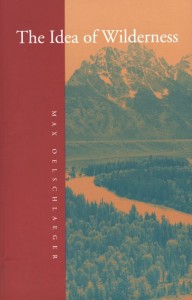 ‘How has the concept of wild nature changed over the millennia? And what have been the environmental consequences? In this broad-ranging book Max Oelschlaeger argues that the idea of wilderness has reflected the evolving character of human existence from Paleolithic times to the present day. An intellectual history, it draws together evidence from philosophy, anthropology, theology, literature, ecology, cultural geography, and archaeology to provide a new scientifically and philosophically informed understanding of humankind’s relationship to nature. ‘How has the concept of wild nature changed over the millennia? And what have been the environmental consequences? In this broad-ranging book Max Oelschlaeger argues that the idea of wilderness has reflected the evolving character of human existence from Paleolithic times to the present day. An intellectual history, it draws together evidence from philosophy, anthropology, theology, literature, ecology, cultural geography, and archaeology to provide a new scientifically and philosophically informed understanding of humankind’s relationship to nature.
Oelschlaeger begins by examining the culture of prehistoric hunter-gatherers, whose totems symbolized the idea of organic unity between humankind and wild nature, and idea that the author believes is essential to any attempt to define human potential. He next traces how the transformation of these hunter-gatherers into farmers led to a new awareness of distinctions between humankind and nature, and how Hellenism and Judeo-Christianity later introduced the unprecedented concept that nature was valueless until humanized. Oelschlaeger discusses the concept of wilderness in relation to the rise of classical science and modernism, and shows that opposition to “modernism” arose almost immediately from scientific, literary, and philosophical communities. He provides new and, in some cases, revisionist studies of the seminal American figures Thoreau, Muir, and Leopold, and he gives fresh readings of America’s two prodigious wilderness poets Robinson Jeffers and Gary Snyder. He concludes with a searching look at the relationship of evolutionary thought to our postmodern effort to reconceptualize ourselves as civilized beings who remain, in some ways, natural animals.’
.
[2] Save Our Suburbs, ^ http://www.sos.org.au/
.
[3] Save The Tree, ^ http://savethetree.org
.
Tags: act locally, an inconvenient truth, Blue Mountains, Blue Mountains City Council, bushphobia, civilisation, conurbation, David Brower, deluded inconvenience, Emilie Travel Livezey, environmental destruction, Eucalyptus burgessiana, Eucalyptus sclerophylla, Faulconbridge, Faulconbridge Mallee Ash, FOE, Friends of the Earth, globalisation, Greater Blue Mountains World Heritage Area, Grose River Sub-catchment, housing encroachment, industrial progress, industrialisation, local character, local residents, Mother Nature, Mount Wellington, NIMBYism, Not In My Backyard, Queenstown, Rare or Threatened Plants (ROTAP), revegetated, rights of locals, Save Our Suburbs, savethetree.org, Significant Tree, Sir Patrick Geddes, Tasmania, terra incognita, The Land & Environment Court of New South Wales, think globally, urban consolidation, wilderness
Posted in Blue Mountains (AU), Tasmania (AU), Threats from Development, Threats from Greenwashing, Threats from Weak Environmental Laws | No Comments »
Add this post to Del.icio.us - Digg
Thursday, June 2nd, 2011
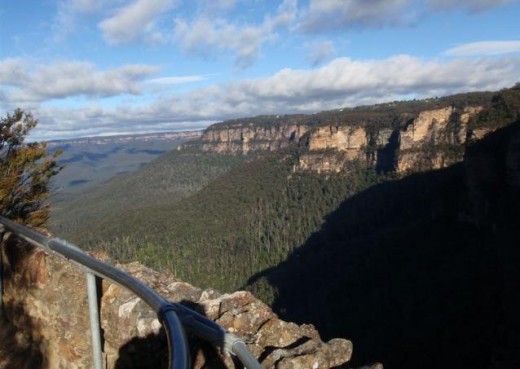 Jamison Valley from Sublime Point, Leura
(Blue Mountains, New South Wales, Australia) Jamison Valley from Sublime Point, Leura
(Blue Mountains, New South Wales, Australia)
.
For those who have purchased an escarpment-edge bush block in Blue Mountains villages of Leura, Wentworth Falls or Katoomba, who have ‘arranged‘ for native escarpment habitat to be killed in order to gain property views to the magnificent Jamison Valley, such actions are selfish and contribute to the ecological vandalism and disappearance of important and scarce escarpment habitat.
For others enjoying the Jamison Valley naturally on foot, to look back up at the Leura escarpment has become an ugly one dominated by increasing housing development.
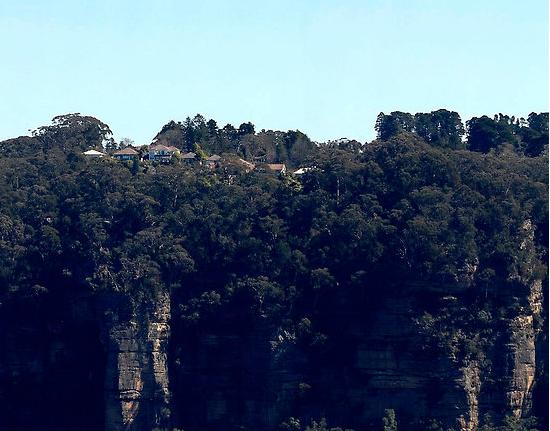
Views are bidirectional, but try explaining that to a property developer or to those real estate agents who only appreciate the sales commission.
On the spectacular escarpment fringe of the much valued village of Leura in the much valued Blue Mountains, not only have the fire-lighters taken a fancy at setting fire to nearby prized escarpment bushland, but the property developers have been in with the bulldozers.
The Blue Mountains (city) Council has for decades signed off on developer applications for clifftop development and consequential deforestation. More recently, Blue Mountains (city) Council continues to happily signed off on approval of applications from subsequent clifftop property owners to ‘hazard reduce’ the surrounding escarpment bushland ~ either to improve the views or to save money having to bushfire protect their properties.
Either way, valuable limited habitat along the Blue Mountains escarpment overlooking the Jamison Valley continues to disappear for new selfish housing views.
All along the Jamison Valley escarpment, the following photos tell a tragic story of the selfish developer destruction of the Jamison Valley Escarpment …
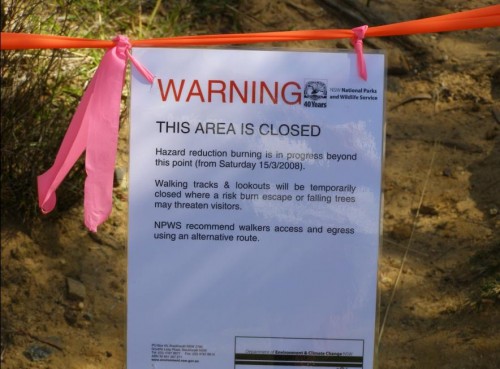 Wildlife Service ‘hazard reduction’ burn notice for Sublime Point escarpment at the end of Willoughby Road, Leura back on 15th March 2008.
(click photo to enlarge) Wildlife Service ‘hazard reduction’ burn notice for Sublime Point escarpment at the end of Willoughby Road, Leura back on 15th March 2008.
(click photo to enlarge)
.
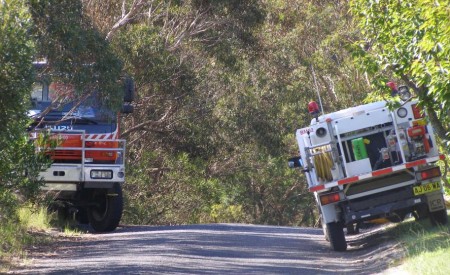 Warrimoo Rural Fire Service set up to conduct hazard reduction at Sublime Point, Leura (Carleton Road, Leura, 15th March 2008). Warrimoo Rural Fire Service set up to conduct hazard reduction at Sublime Point, Leura (Carleton Road, Leura, 15th March 2008).
.
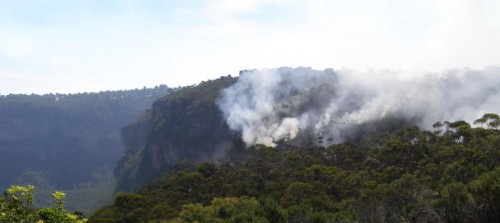
Rural Fire Service setting fire to escarpment vegetation at Sublime Point on the Jamison Escarpment, Leura. (Photo from Willoughby Road,Leura, 15th March 2008).
.
A year later again at Sublime Point…
.
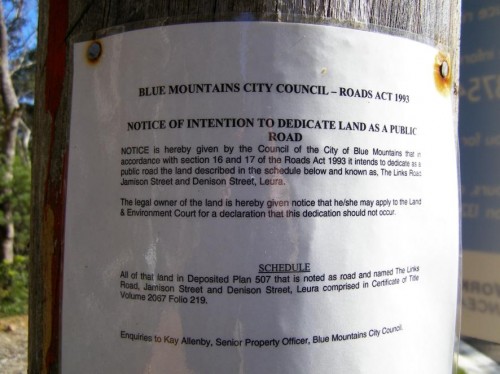 DECC Wildlife Service ‘hazard reduction’ burn notice for Sublime Point escarpment again on 24th March 2009, almost exactly a year to the date. DECC Wildlife Service ‘hazard reduction’ burn notice for Sublime Point escarpment again on 24th March 2009, almost exactly a year to the date.
.
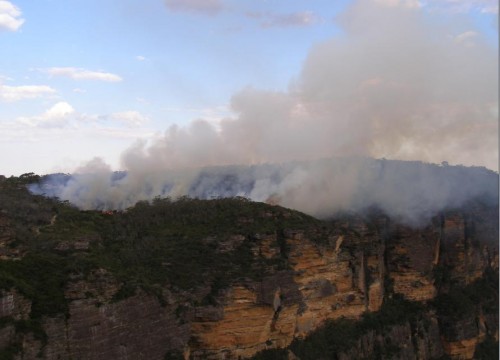 Blue Mountains Wildlife Service ‘hazard reduction’ burn of the Jamison Escarpment at Sublime Point 24th March 2009 Blue Mountains Wildlife Service ‘hazard reduction’ burn of the Jamison Escarpment at Sublime Point 24th March 2009
.
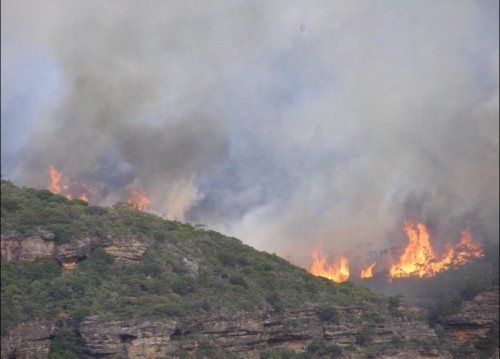 Blue Mountains Wildlife Service ‘hazard reduction’ burn of the Jamison Escarpment at Sublime Point 24th March 2009. Blue Mountains Wildlife Service ‘hazard reduction’ burn of the Jamison Escarpment at Sublime Point 24th March 2009.
.
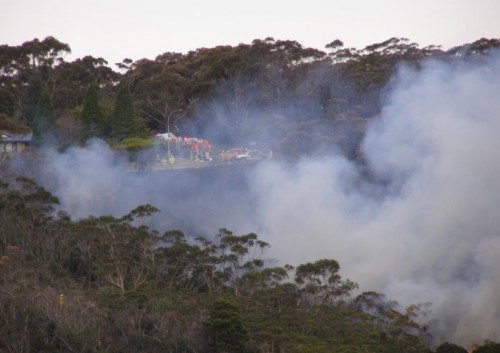 Fire-lighters watching on as their blaze gets out of control at Sublime Point 24th March 2009.
(Click photo for enlargement) Fire-lighters watching on as their blaze gets out of control at Sublime Point 24th March 2009.
(Click photo for enlargement)
.
.
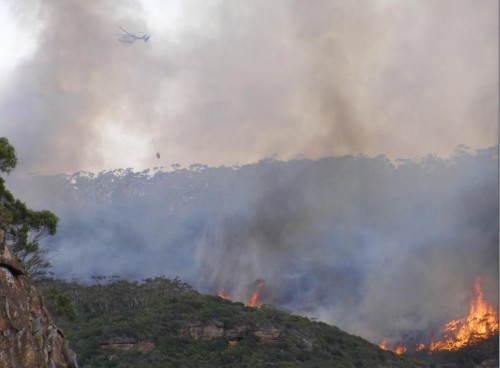 Same ‘hazard reduction’ burn out of control, requiring expensive and embarrassing helicopter water-bombing to stop the fire spread down into the protected Jamison Valley Same ‘hazard reduction’ burn out of control, requiring expensive and embarrassing helicopter water-bombing to stop the fire spread down into the protected Jamison Valley
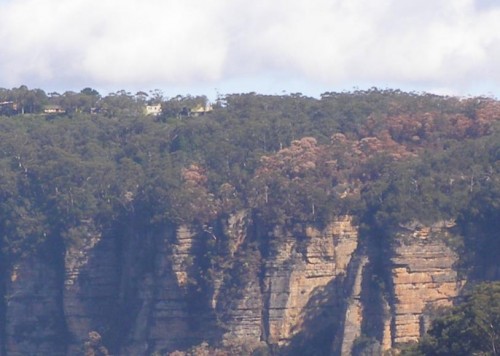 East side of Sublime Point (5th April 2009) showing burnt vegetation, where the HR burning had escaped and nearly entered down into the Jamison Valley.
(The media spin by bushfire management was that this section was arson, but not surprisingly the culprit was never found). East side of Sublime Point (5th April 2009) showing burnt vegetation, where the HR burning had escaped and nearly entered down into the Jamison Valley.
(The media spin by bushfire management was that this section was arson, but not surprisingly the culprit was never found).
.
nec.
Meanwhile, property developers at Sublime Point, a block away…
.

Leura’s recently approved and created ‘ The Links Road‘ (31st May 2008) following Council approved destruction of escarpment vegetation and subsequent subdivision ready for escarpment housing..with views.
.
Meanwhile, further along Cliff Drive at Katoomba…
.
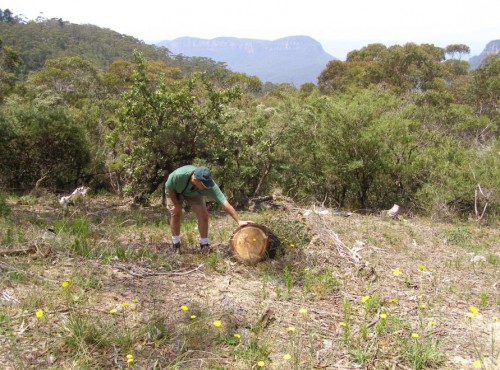 Editor inspecting native escarpment site on Cliff Drive, Katoomba back on 12th January 2008 that had been recently slashed by the Wildlife Service.
It just so happened that a house opposite on Cliff Drive was up for sale and would benefit from the fresh views of the Jamison Valley. Editor inspecting native escarpment site on Cliff Drive, Katoomba back on 12th January 2008 that had been recently slashed by the Wildlife Service.
It just so happened that a house opposite on Cliff Drive was up for sale and would benefit from the fresh views of the Jamison Valley.
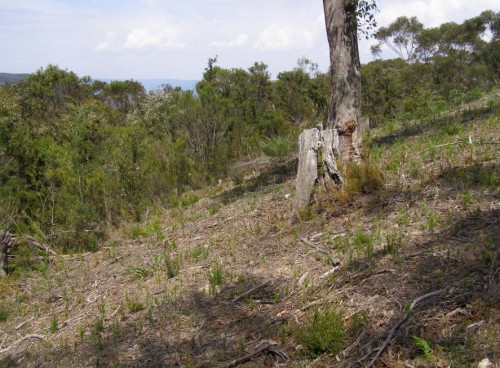 Same site, same date. Same site, same date.
.
 Seven months later, a few hundred metres west along Cliff Drive Katoomba,
some developer gets escarpment views towards Nellies Glen approved,
or is it more a case of ‘overlooked‘ by Blue Mountains (city)Council? Seven months later, a few hundred metres west along Cliff Drive Katoomba,
some developer gets escarpment views towards Nellies Glen approved,
or is it more a case of ‘overlooked‘ by Blue Mountains (city)Council?
.
.
.
-end of article –
Tags: Blue Mountains City Council, Blue Mountains western escarpment, Blue Mountains World Heritage Area, bushland housing, hazard reduction, housing encroachment, Jamison Valley, Katoomba, Leura, Links Road, NPWS, prescribed burning, Sublime Point, Wentworth Falls, Wildlife Service
Posted in Blue Mountains (AU), Threats from Bushfire, Threats from Development | No Comments »
Add this post to Del.icio.us - Digg
Saturday, May 28th, 2011
Valuable fringe bushland of the Central Blue Mountains (BM) is steadily disappearing as a consequence of Blue Mountains (city) Council-approved housing development integrated with the associated hazard reduction burning that it invites.
Blue Mountains Council has become culturally conditioned to automatically squirm and acquiesce when any threat of a State Environmental Court appeal process that may be instigated to dare challenge Blue Mountains Council, despite a fair and rigorous environmental assessment and ruling. Local political pressure is such that now Blue Mountains Council staff are encouraged to give up and bend over, as if so urbane as to be beholden to developer intimidation. Yet for years such has become Blue Mountains Council’s urbane squeamish mindset, as if the staff and management came from overdeveloped Western Sydney (which most of them they have).
There are morally corrupt politics controlling land use development in the Blue Mountains ~ many are receiving a cut of perceived cheap, yet increasingly scarce, bushland habitat.
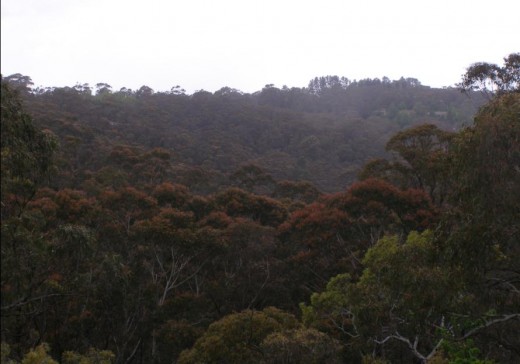 Thick natural bushland habitat just west of Katoomba
Central Blue Mountains Region.
New South Wales, eastern Australia. Thick natural bushland habitat just west of Katoomba
Central Blue Mountains Region.
New South Wales, eastern Australia.
.
.
Case in point:
.
Not so long ago, Blue Mountains Council approved this cypress pine cottage be built in/abutting thick timbered bushland on a west facing slope downwind of the prevaling westerly winds.
Bushfire risk mapping rated the site as ‘extreme’ bushfire risk, yet the cypress pine cottage got built. The builder/developer has long since profited and so moved on, leaving behind a bushfire vulnerable cottage on a site that should never have been built on in the first place.
But try telling a pro-development council that a property owner can’t develop his/her land!
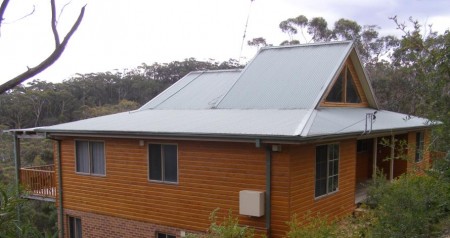 The cypress pine cottage, 2008
. The cypress pine cottage, 2008
.
The site was purchased in/abutting dense wooded bushland, which was slashed and bulldozed. Down from the house, around a dozen mature native trees were chainsawed to provide for escarpment views to the west.
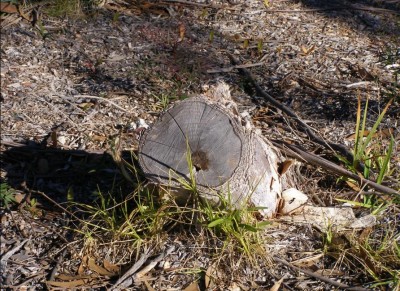 One of the chainsawed native trees
. One of the chainsawed native trees
.
The property has since been sold. Yet, the issue of a cypress clad cottage being approved in extreme fire risk bushland was raised with Blue Mountains Council’s senior development officer, Lee Morgan, on 25-Feb-2009 (Council ref. Customer Service Request #106889). But there was no response.
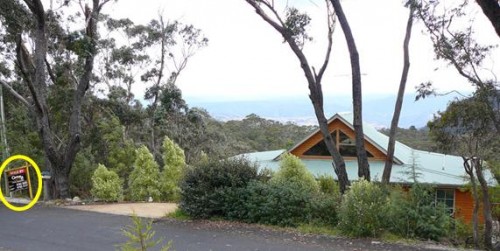 The cottage was sold in 2008…with views
…less the dozen chainsawed Eucalypts to make way for the views. The cottage was sold in 2008…with views
…less the dozen chainsawed Eucalypts to make way for the views.
.
It is typical of Blue Mountains Council’s planning approvals that they encourage development encroachment on the fringe bushland which separates the Blue Mountains National Park from the townships of the Central Blue Mountains.
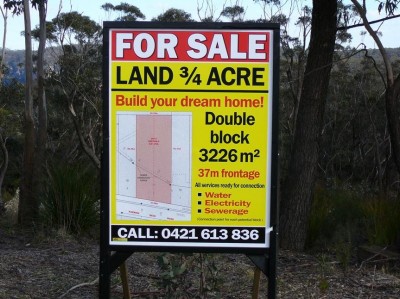
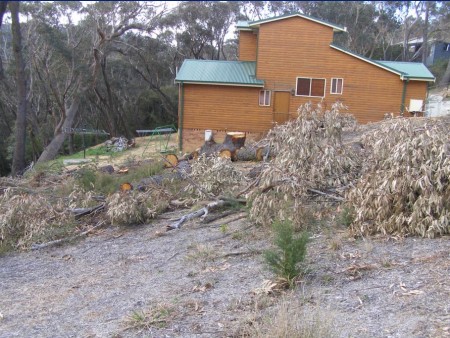 A nearby cottage of remarkably similar cypress pine cladding
has surrounding trees chainsawed and the vegetation slashed to bare earth. A nearby cottage of remarkably similar cypress pine cladding
has surrounding trees chainsawed and the vegetation slashed to bare earth.
.
.
Then comes the ‘hazard’ reduction
.
Housing development encroachment is being wedged deeper into fringe bushland, closer to the Blue Mountains National Park, many seeking the profit that escarpment views bring. The sites are indefensible against bushfire. Many are zoned extreme bushfire risk, yet these bush houses received Council building approval.
The Rural Fire Service (RFS) calls for hazard reduction because, with just its truck resources, it would not have access to defend these houses in the event of a serious bushfire. Co-incidentally, the property owners (developers) now cry for RFS hazard reduction to protect their ‘assets’ from the risk of bushfire. Co-incidentally, many property owners (developers) in the vicinity who have these new bush houses do the same.
Of course, to the fire-lighting cult, this is music to their ears and so the Rural Fire Service in cohorts with Blue Mountains Council rustled up a hazard reduction certificate. In September 2008, Blue Mountains Council’s Bushfire Technical Officer, Peter Belshaw, issued a Hazard Reduction Certificate for over 11 hectares of bushland and escarpment heath across Bonnie Doon Reserve to be burnt under a ‘hazard’ reduction programme. Click on image below for details.
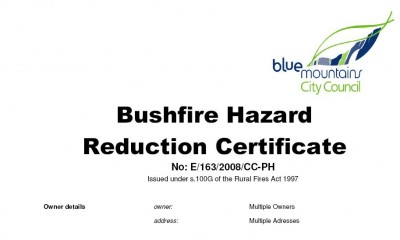 Click image to open PDF document Click image to open PDF document
.
Earlier that year in mid February (2008), some seven months prior, slashing of heathland and a watercourse had been carried out by a Rural Fire Service contractor in preparation for the hazard reduction burning ~ the fire-lighters just couldn’t wait.
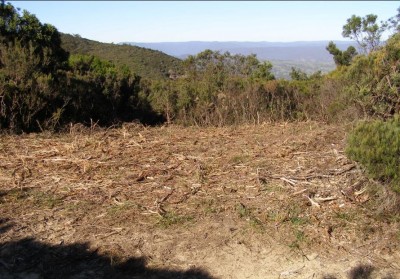 Blue Mountains escarpment is slashed by the RFS, a kilometre west of the cottage site. Blue Mountains escarpment is slashed by the RFS, a kilometre west of the cottage site.
.
.
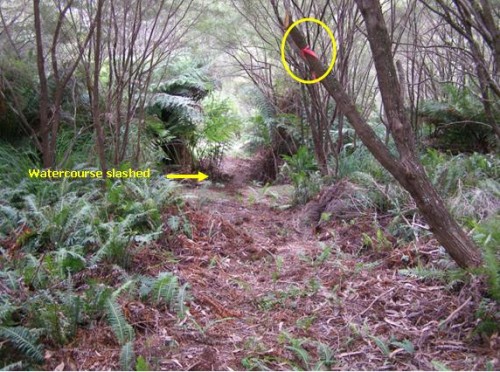 The RFS contractor slashed a trail for over 700m through heathland and through a riparian zone,
even before the Hazard Reduction Certificate was issued.
.
The RFS contractor slashed a trail for over 700m through heathland and through a riparian zone,
even before the Hazard Reduction Certificate was issued.
.
Then comes the intense HR burning:
.
Three years hence, mid afternoon on Friday 11th February 2011, smoke can be smelt and seen rising to the west on the horizon near Bonnie Doon Reserve. A call to emergency ‘000’ confirms that it is not a bushfire, but that official hazard reduction operations are underway. It is still well within the bushfire risk season.
.
Bonnie Doon Reserve is a natural wild area of about 22 hectares that includes a mix of bushland, heathland and upland swamp situated on the Blue Mountains escarpment at the western fringe of the township of Katoomba. It lies above Bonnie Doon Falls. The area is zoned ‘community land’ and ‘environmental protection’ and comes under the control and custodianship of the Blue Mountains Council. Bonnie Doon Reserve has a history of volunteer bushcare to conserve the still wild Blue Mountains escarpment habitat. The reserve is immediately upstream of the endangered Dwarf Mountain Pine (Microstrobos fitzgeraldii) and Leionema lachnaeoides (yellow flowering shrub) found almost nowhere else on the planet. The habitat conservation of both species, particularly the exclusion of fire are considered critical to their survival as a species.
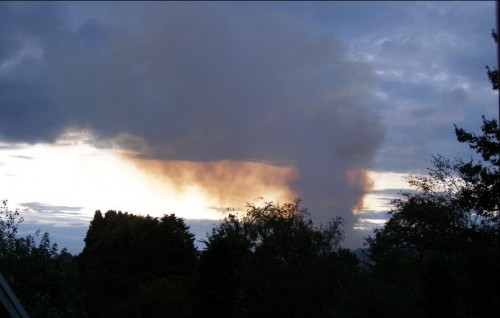 The ‘hazard’ reduction (HR) burning commences The ‘hazard’ reduction (HR) burning commences
.
From a distance of about two kilometres, I can see the smoke billowing strongly and its lasts for over two hours. The direction of the smoke places it around Bonnie Doon Reserve. The strength and density of the smoke indicates that it is more than light burning of ground cover. It is an intense but localised fire.
.
The aftermath of the burning:
.
We have our suspicions, but with other commitments we can’t get around there for some time to investigate the location affected to determine the scale and severity of the burning. In fact it isn’t until nearly three months later on Sunday 1st May 2011, that we inspect the burnt site. The fire was localised.
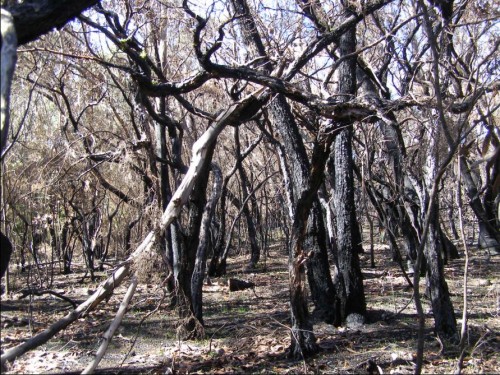 The aftermath
Three months on, evidence of more than just ground-cover has been burnt.
Deliberate intense burning has been allowed to penetrate deep into mature Eucalypts The aftermath
Three months on, evidence of more than just ground-cover has been burnt.
Deliberate intense burning has been allowed to penetrate deep into mature Eucalypts
.
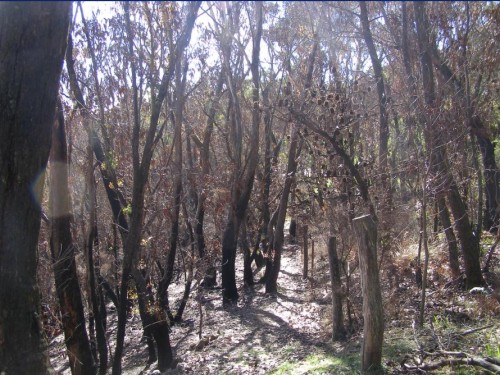
.
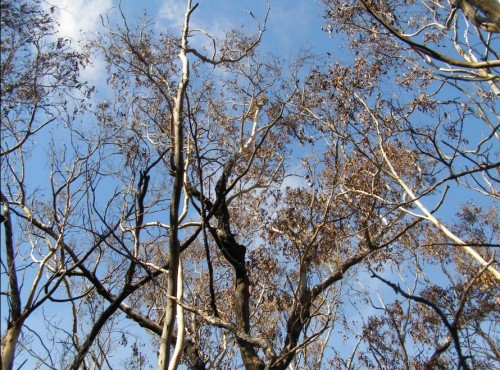 The fire was so intense that the flames reached into the tree canopy.
It must have been a blaze and half for RFS fire-lighters. The fire was so intense that the flames reached into the tree canopy.
It must have been a blaze and half for RFS fire-lighters.
.
.
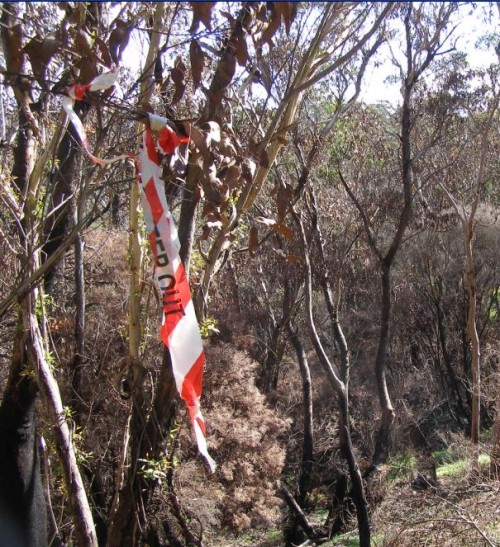 RFS telltale
. RFS telltale
.
The fire was indeed localised. It is very clear, still three months on, that this ‘hazard’ reduction burn had specifically targeted the native bushland surrounding the cypress cottage – an area of perhaps two hectares.
Consequence:
So not only has the developer of the cottage site completely destroyed the bushland on the site, but he has succeeded in having an additional two hectares burnt in the process all associated with the one cottage. Council’s initial approval of the cottage construction has directly led to the destruction of two hectares of what began as intact native bushland. The developer has profited from the bush, but in the process the ecological cost has been ignored ~ it is a perpetuation of a 19th and 20th Century single bottom line exploitation of the natural environment. It is happening across the Blue Mountains and being encouraged by Blue Mountains Council rules, practices and attitudes.
.
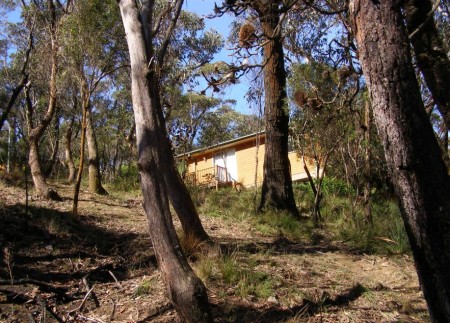 The cottage relative to the HR burn (aftermath) The cottage relative to the HR burn (aftermath)
.
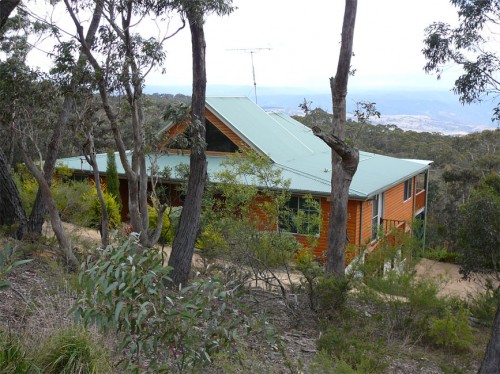
The cottage now with great views, plus an extra 2 hectares of cleared bush done cheap
Blue Mountains (city) Council making bushland-fringe development cheap
.
The ‘hazard’ reduction certificate process has become an insidious part of the development process across the Blue Mountains. The catalyst that is Council’s lax bushland protection zoning, is facilitating fringe deforestation. The combination of Council’s housing approvals on bush blocks with its ‘hazard’ reduction approvals have become a self-perpetuating twin mechanism for incremental encroachment into Blue Mountains fringe bushland, and it shows no sign of stopping.
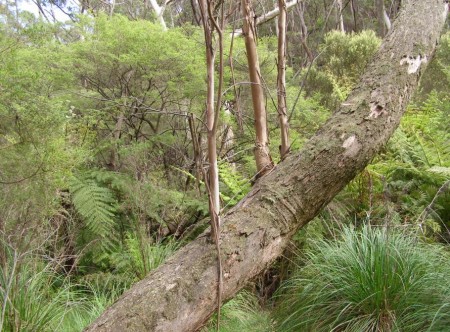 Bushland habitat at Bonnie Doon at risk of further burning Bushland habitat at Bonnie Doon at risk of further burning
.
Hazard reduction has become a cosy win-win-win-win outcome for all collaborators: (1) the builder/developer who profits, (2) the real-estate agent who get the sales commission (first when the bush block is sold, then again when the house is sold with views), (3) Council which earns developer charges in the short term and an expanded rate revenue base over the long-term, and (4) the RFS fire lighters who have become more adept and occupied lighting bushfires than putting them out.
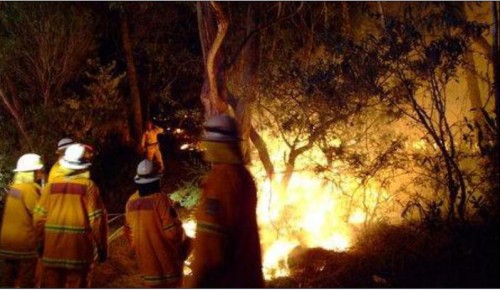 Fire-lighters look on during the Hazard Reduction Burn, Bonnie Doon Reserve Fire-lighters look on during the Hazard Reduction Burn, Bonnie Doon Reserve
.
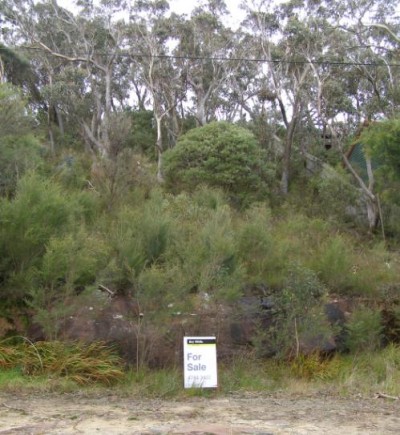 More bushland for sale
~ a ‘lose-lose’ outcome for native habitat and the remnant disappearing wildlife is supports.
More bushland for sale
~ a ‘lose-lose’ outcome for native habitat and the remnant disappearing wildlife is supports.
.
An harbinger of more burning for Bonnie Doon:
.
Of the eleven odd hectares of the 22 ha Bonnie Doon Reserve targeted by the RFS for slashing and burning on the hazard reduction certificate, nine hectares of bushland and escarpment heathland still stands to be burnt, which could happen anytime.
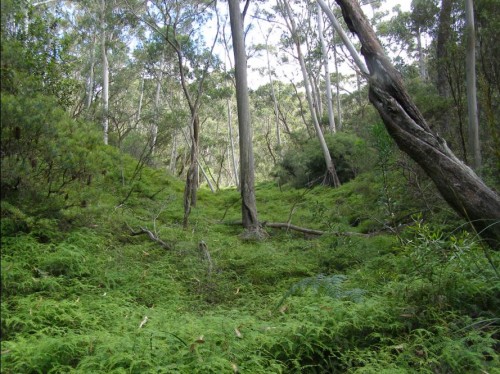 Bonnie Doon Reserve
on the western fringe of Katoomba township Bonnie Doon Reserve
on the western fringe of Katoomba township
(click photo to enlarge)
(Photo by us, so free in public domain)
.
– end of article –
.
 Blue Mountains escarpment is slashed a kilometre west of the house site Blue Mountains escarpment is slashed a kilometre west of the house site
, in preparation for over 11 hectares of buring Bonnie Doon Reserve
Tags: Blue Mountains City Council, Blue Mountains National Park, Blue Mountains World Heritage Area, Bonnie Doon Reserve, bush block for sale, bush fringe development, bush profits, bushland housing, Dwarf Mountain Pine, extreme bushfire risk, hazard reduction, hazard reduction certificate, housing encroachment, Leionema lachnaeoides, Microstrobos fitzgeraldii, property development, real estate land sales, Rural Fire Service, slashing
Posted in Blue Mountains (AU), Threats from Bushfire, Threats from Deforestation, Threats from Development | No Comments »
Add this post to Del.icio.us - Digg
|
|
 Pyrocumulus cloud as the Grose Valley goes up in smoke on 23rd November 2006
Pyrocumulus cloud as the Grose Valley goes up in smoke on 23rd November 2006
 McIntyre’s Hut Fire 20030108 – distant, isolated and remote at this stage.
Ten days later it became the 2003 Canberra Firestorm
McIntyre’s Hut Fire 20030108 – distant, isolated and remote at this stage.
Ten days later it became the 2003 Canberra Firestorm An aerial view of a fire-devastated Chauvel Circle in the suburb of Chapman on 21st January, 2003 in Canberra,
where 15 of 20 homes in the street were destroyed by fire.
Four people were killed and 419 homes destroyed when the fires being fought on five fronts swept through the nation’s capital.
(Photo by Daniel Berehulak, Getty Images)
An aerial view of a fire-devastated Chauvel Circle in the suburb of Chapman on 21st January, 2003 in Canberra,
where 15 of 20 homes in the street were destroyed by fire.
Four people were killed and 419 homes destroyed when the fires being fought on five fronts swept through the nation’s capital.
(Photo by Daniel Berehulak, Getty Images)
 The Hartley Vale backburn 20061115 escaped up Hartley Vale Road and over the Darling Causeway (above) toward the Grose Valley to the right
(Photo by Editor 20070204, free in pubic domain, click to enlarge)
The Hartley Vale backburn 20061115 escaped up Hartley Vale Road and over the Darling Causeway (above) toward the Grose Valley to the right
(Photo by Editor 20070204, free in pubic domain, click to enlarge)



































































